| Travel Photos Home Page |
Rome, Italy 2018... Part Two
|
||||
|
The East Bank of the River Tiber
|
|||||
|
To return to the Paintings section of this website, please CLICK HERE
|
|||
 |
|||
| We are now exploring the East Bank of the River Tiber. Here we find most of the remains of the Ancient Roman city which was at the heart of the Roman Empire. The ruins above are close to the Piazza Venezia.
The tall cylindrical column is a monument to the Emperor Trajan. His statue once stood at the top of the column, but it was replaced in the Christian era with a statue of Saint Peter. When I first saw this monument decades ago, I thought that it may have been made with solid blocks of stone or marble. I later discovered that it was actually hollow and there was a spiral staircase all the way to the viewing platform at the top. I have never met anyone who has climbed those stairs! |
|||
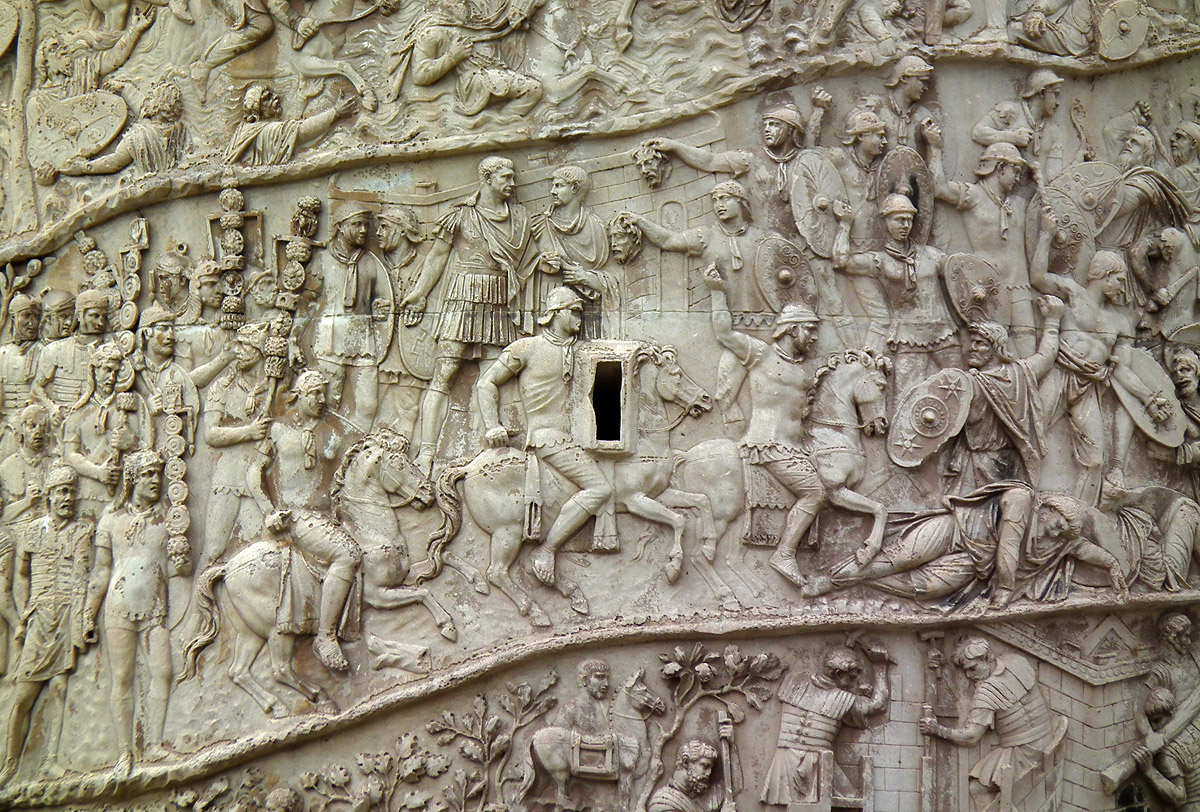 |
|||
| This is a tiny fragment of the spiral decoration on Trajan's Column. The Column celebrates his military victories. Right at the centre of this photo we can see a little window to give light and to help those inside to climb up the spiral staircase to the top.
What is interesting is that the horses being ridden by the cavalry here seem to be quite small. Is this artistic license on the part of the sculptors or were the war horses at that time really so small? Please use the Contact Page of my website to email me if you know the answer! |
|||
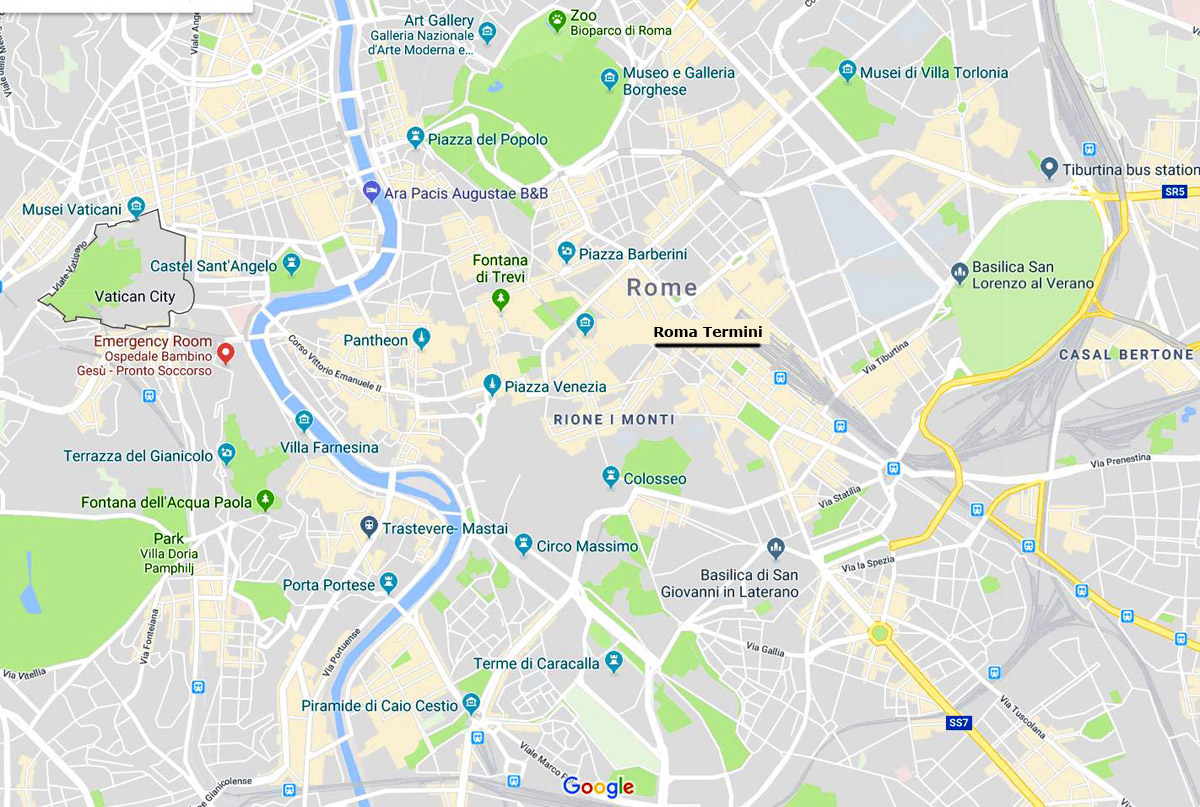 |
|||
| This is a map of present day Rome. You can see that the Piazza Venezia is just to the West of Roma Termini, the main railway station in Rome.
On this map you can also see the locations of the Colosseum (Colosseo) and the Circus Maximus (Circo Massimo). The Arch of Constantine is close to the Colosseum. |
|||
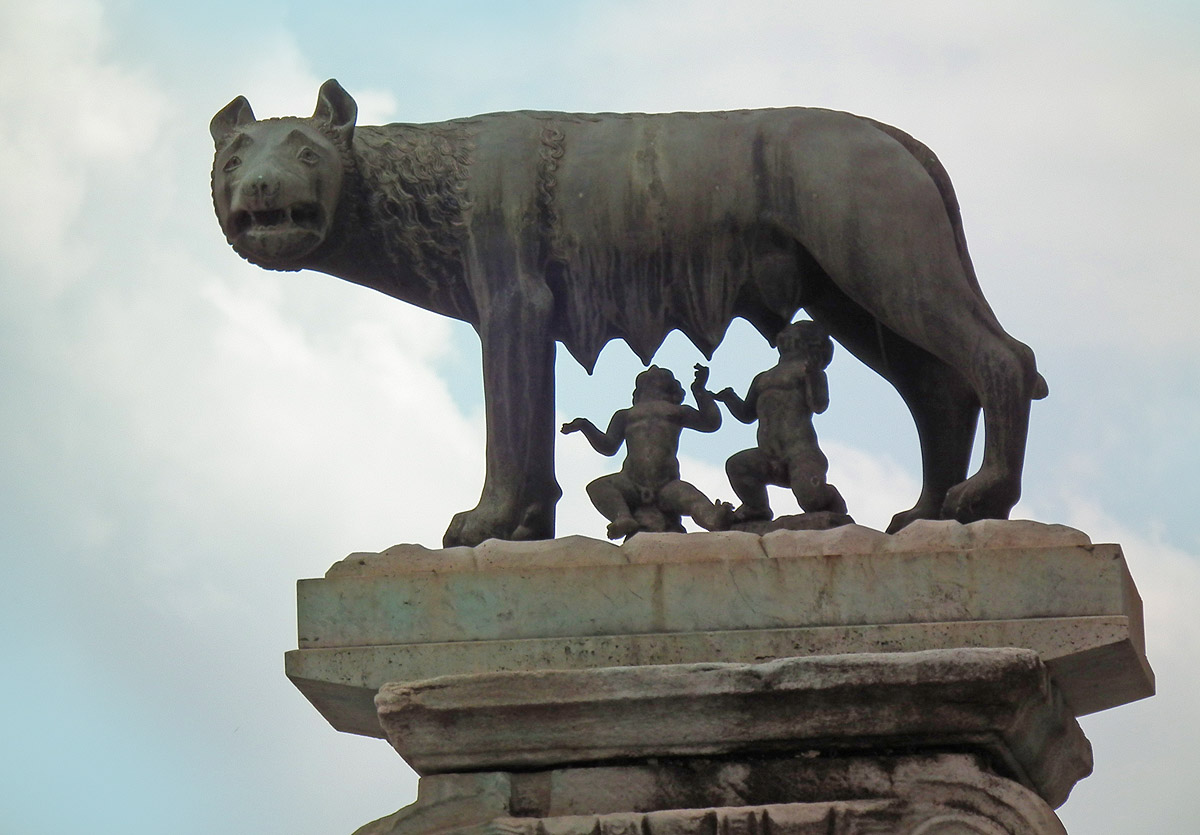 |
|||
| This was the symbol of Ancient Rome. Wikipedia states:
"According to the founding myth of Rome, the city was founded on 21 April 753 BC by the twin brothers Romulus and Remus, who descended from the Trojan prince Aeneas, and who were grandsons of the Latin King Numitor of Alba Longa. King Numitor was deposed by his brother, Amulius, while Numitor's daughter, Rhea Silvia, gave birth to the twins. Because Rhea Silvia had been raped and impregnated by Mars, the Roman god of war, the twins were considered half-divine. What a romantic story! |
|||
 |
|||
| The Roman Empire at the height of its power ruled over an estimated 50 to 90 million people, which was roughly 20% of the world's population. It covered about 5 million square kilometres.
It started as a Monarchy; then became a Republic; and finally ended up as an autocracy ruled by Emperors who were called Caesars, after Julius Caesar, the first Autocrat. For most of its history, the Empire was ruled from the Ancient City of Rome, before it was divided between Rome and Constantinople. |
|||
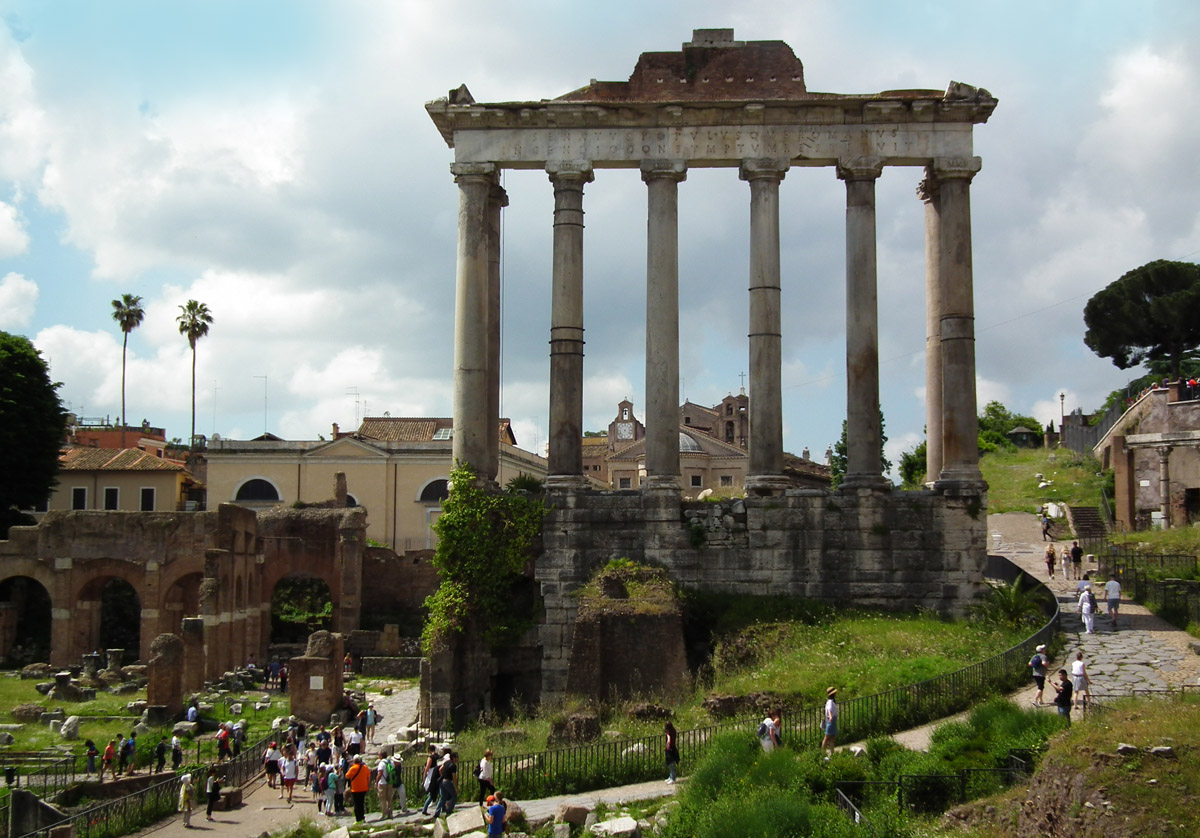 |
|||
| There are extensive ruins stretching from Trajan's Column and the Foro Romano all the way along the Palatine Hill towards the Circo Massimo. | |||
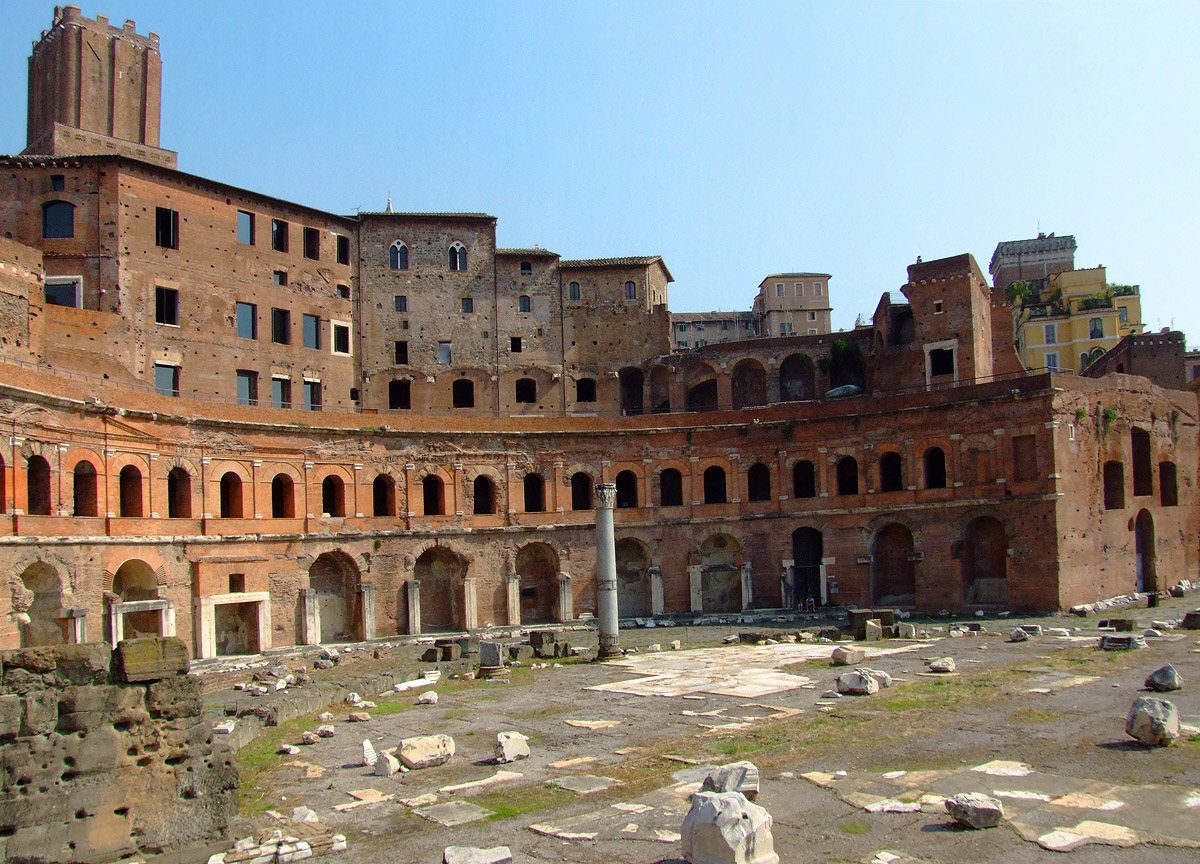 |
|||
| Ancient Rome sported multi-storied apartment buildings and shopping malls as well as all the Temples and Monuments to various Caesars.
Apart from marble and granite, the Ancient Roman builders were skilled in the use of their traditional narrow red bricks and their long-lasting concrete. |
|||
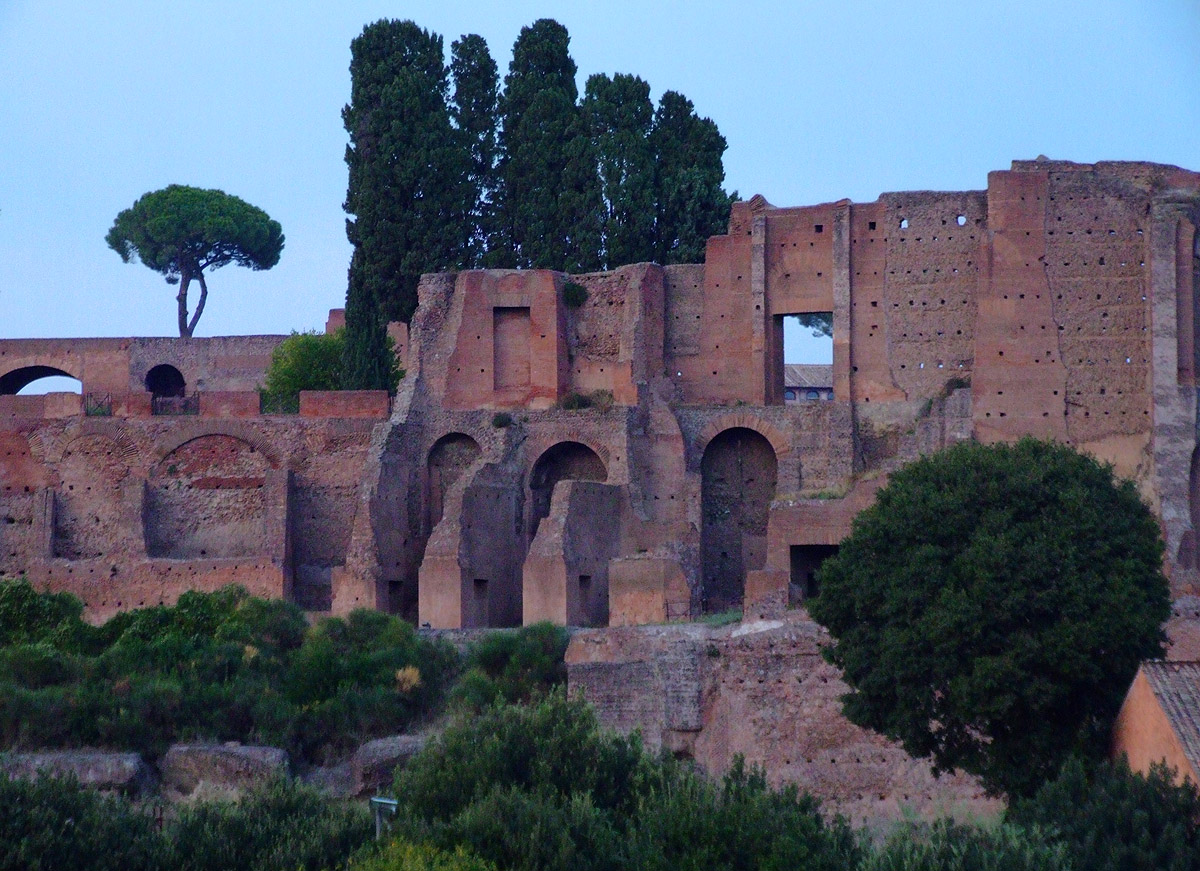 |
|||
| Buildings on the Palatine Hill. | |||
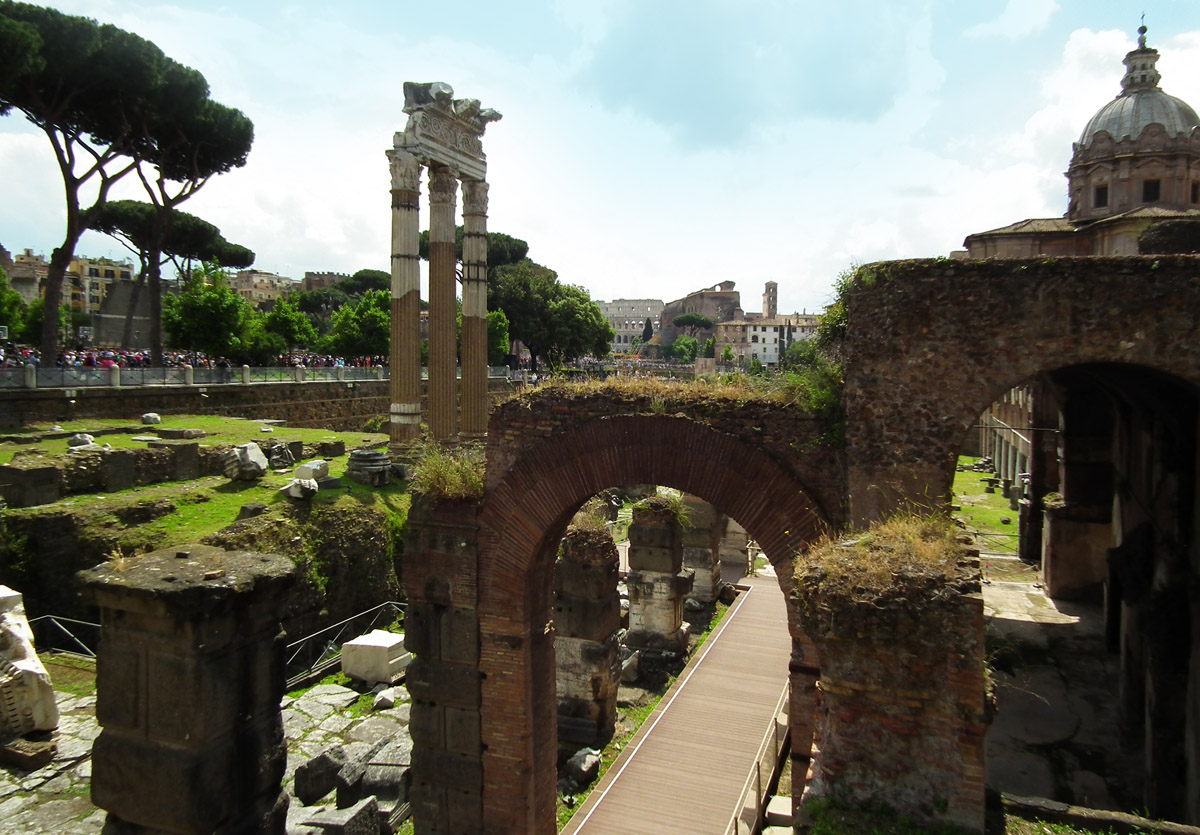 |
|||
| At the front of this photo we can clearly see the use of narrow red bricks forming a typical Roman Arch. | |||
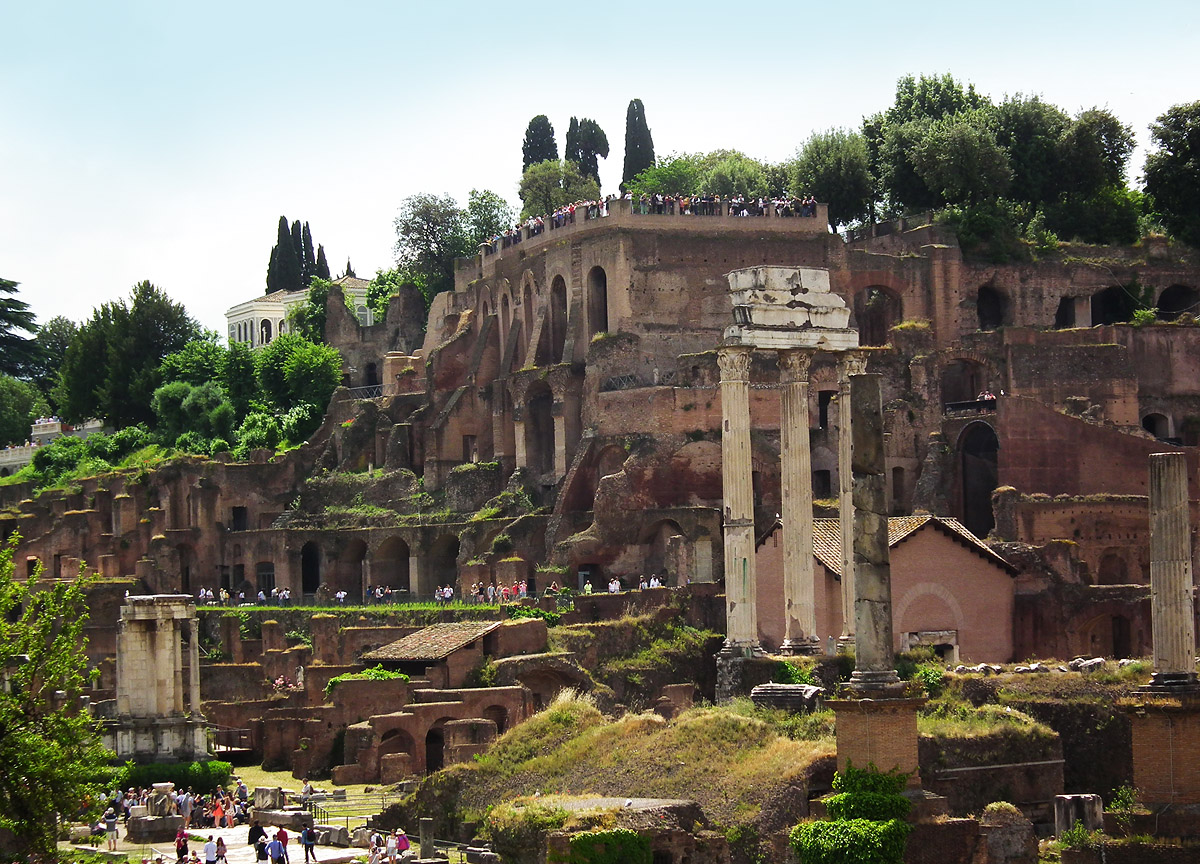 |
|||
| The people in this photo tell us about the scale of these immense building projects. | |||
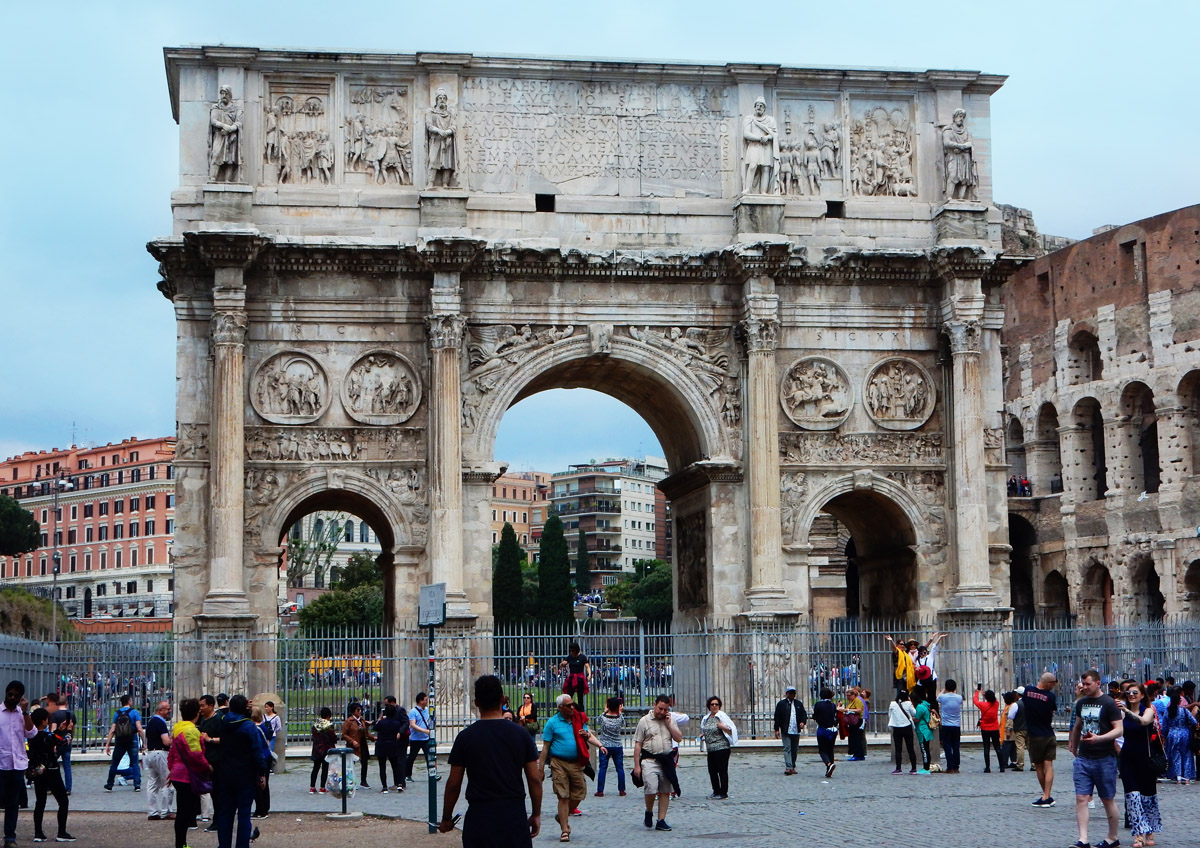 |
|||
| This is the Arch of Constantine, the Emperor who stopped the persecution of Christians in Ancient Rome.
Constantine, born a Roman Pagan, converted to this "new" monotheisitc religion, based significantly upon the Roman crucifixion of a Jew called Jesus. An amazing turning point in history. |
|||
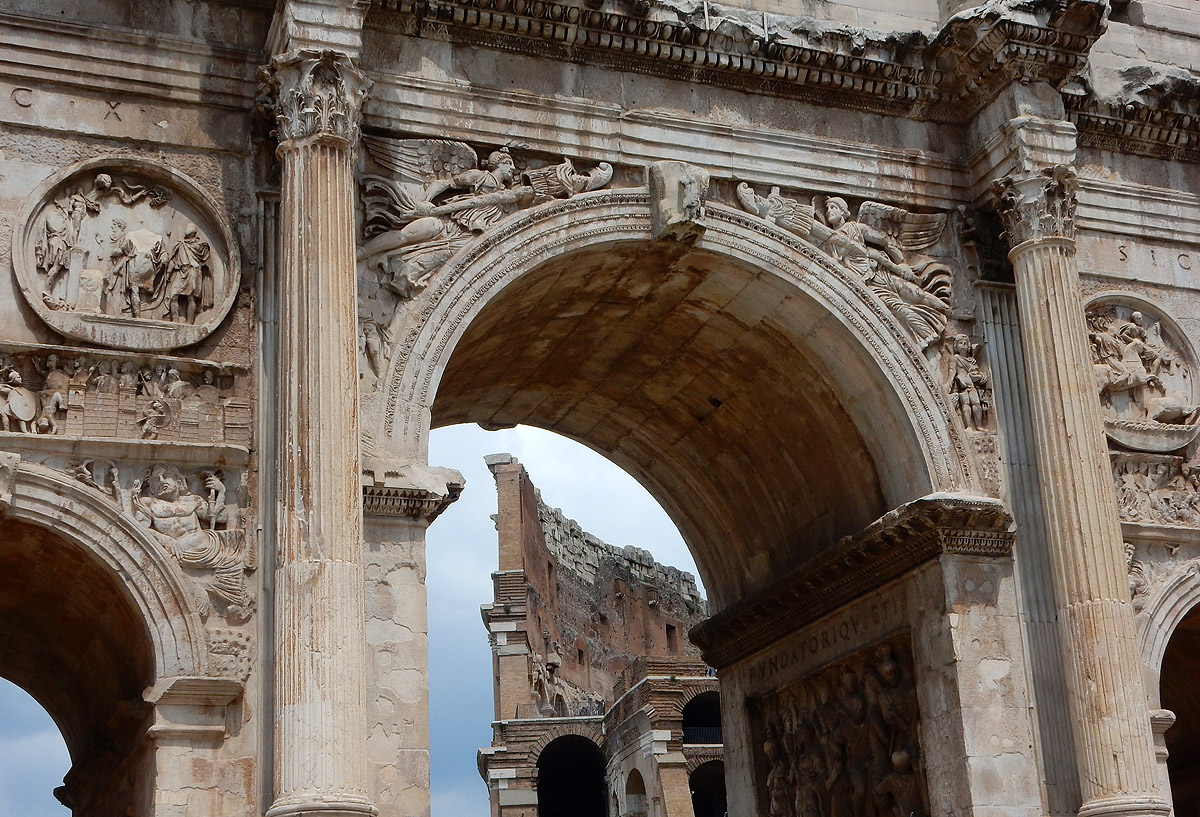 |
|||
| A close up shot of the Arch of Constantine. Through the arch itself we get a glimpse of the Colosseum.
The Arch commemorates the military achievements of Constantine, who was a shrewd and very successful Imperial warrior. |
|||
 |
|||
| The Colosseum. | |||
 |
||
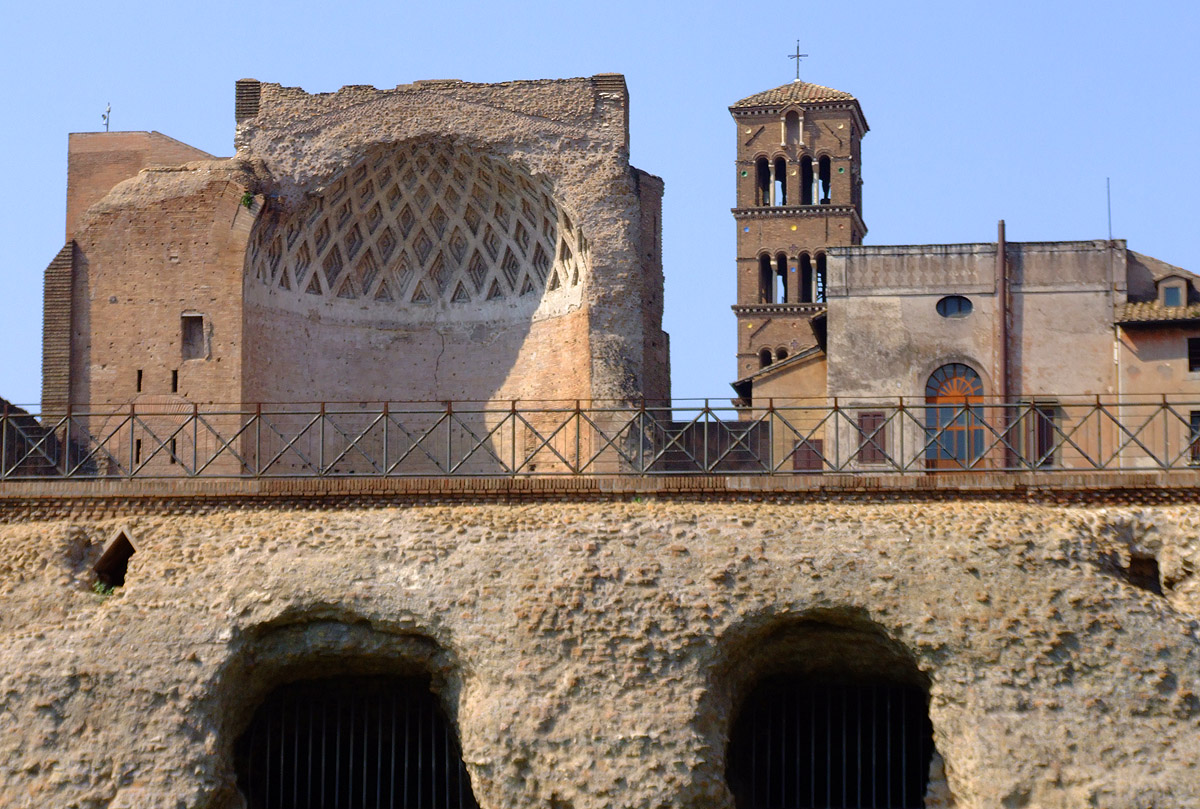 |
||
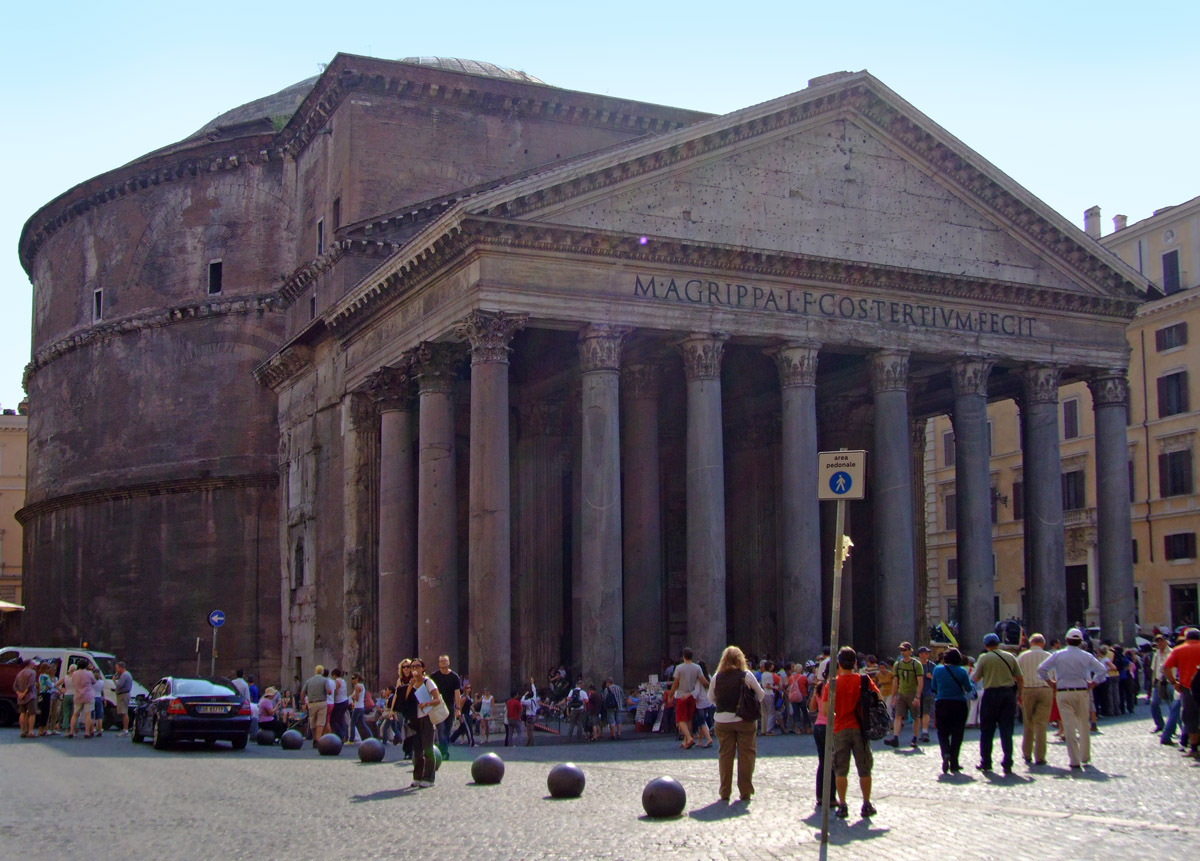 |
|||
| We now head North past the Piazza Venezia to the amazingly well-preserved Roman Pantheon. A Roman Temple was first built here during the reign of Augustus (27 BC - 14 AD), but is was destroyed by fire. The present building was constructed by the Emperor Hadrian in about 126 AD.
It was converted to a Christian Church in the 7th Century AD, dedicated to "St. Mary and the Martyrs", and was popularly known as Santa Maria Rotonda. In front of the round main structure, there is a massive portico with large granite Corinthian columns. |
|||
 |
|||
| The roof covering the round building is a massive dome with a circular hole at its centre.
Amazingly, the dome of the Pantheon is still the world's largest unreinforced concrete dome. The diameter of the circular interior of the Pantheon and the height from the floor to the eye of the dome is the same... 43 metres. |
|||
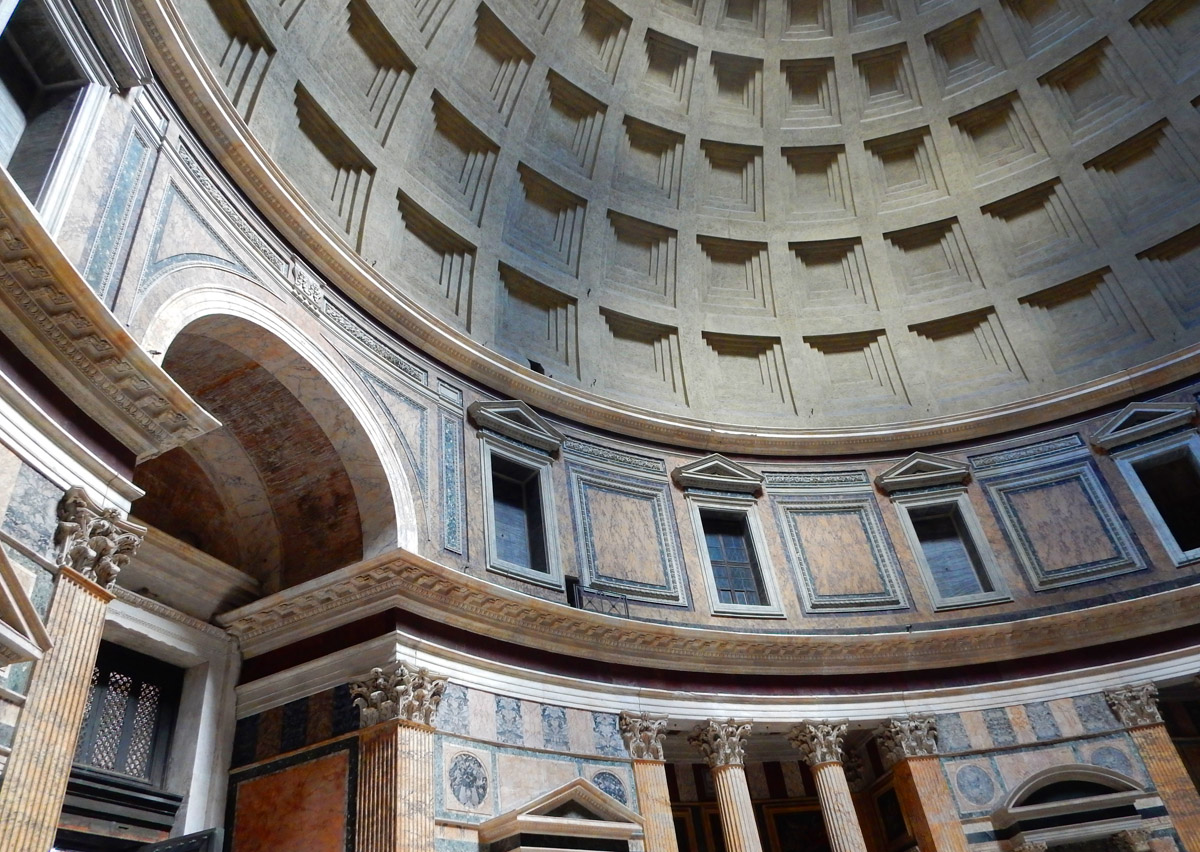 |
||
 |
|||
| As you can see, the Pantheon is a very popular tourist destination. I understand that it is still a functioning Church. | |||
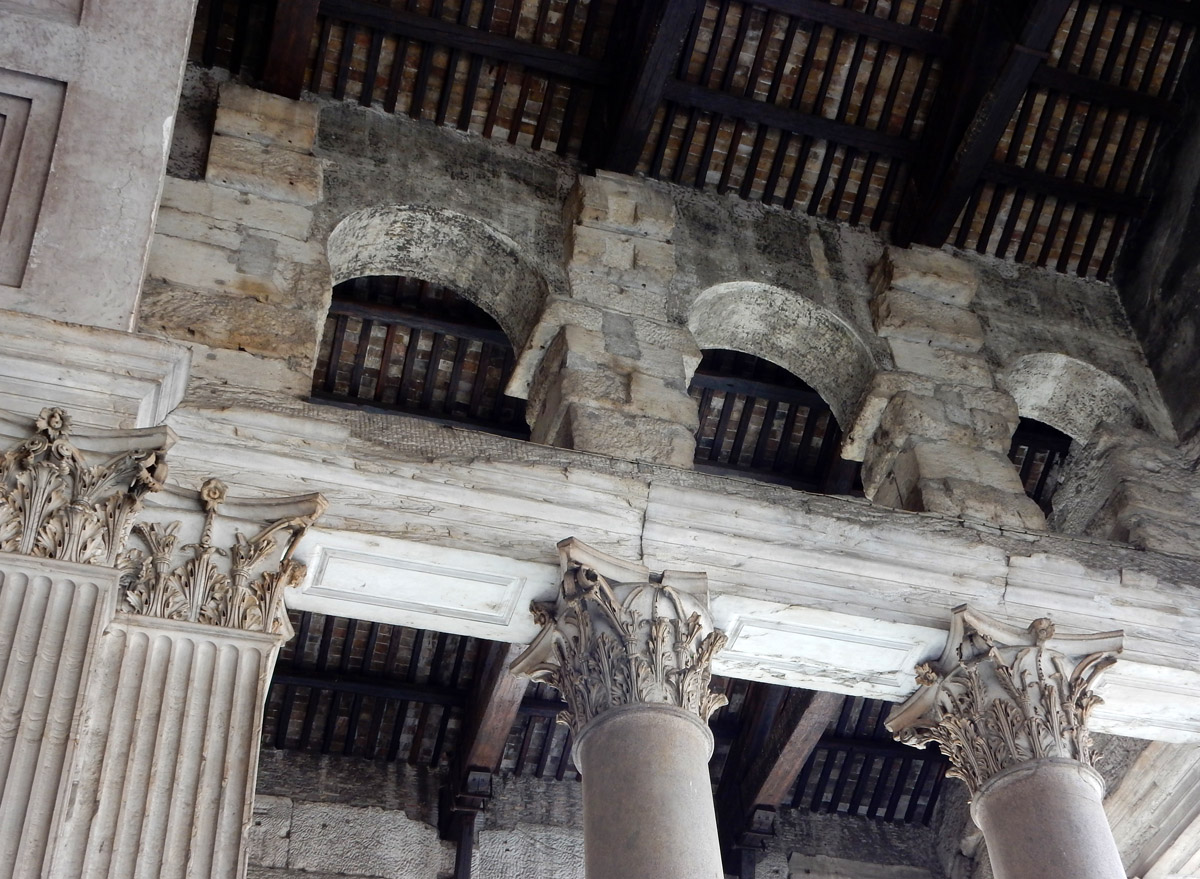 |
|||
| This is the roof of the Portico of the Pantheon, showing the Corinthian capitals of the columns. | |||
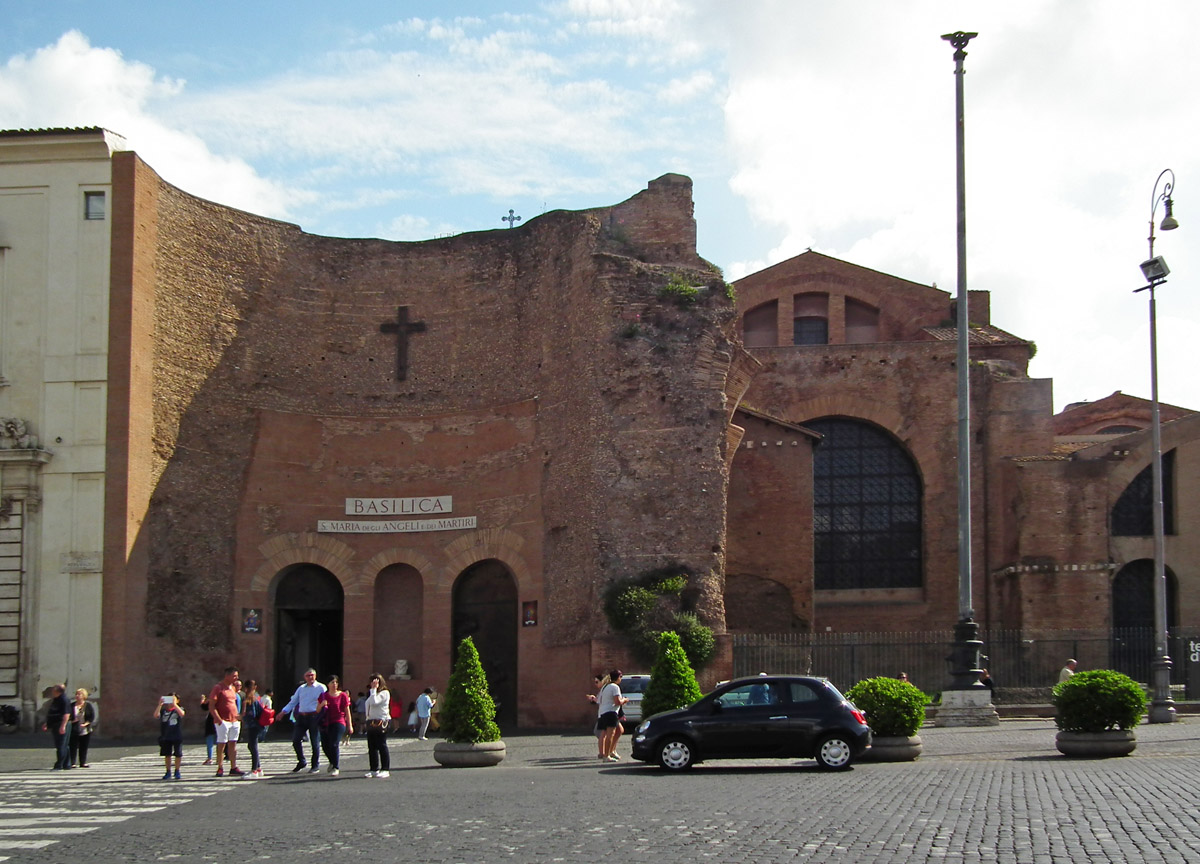 |
|||
| We now head close to the Roma Termini, the main railway station of Rome. Just to the North of the station we find the ruins of the Ancient Diocletian Baths, a part of which was converted to a Christian church in the 16th Century AD. It became the Basilica Santa Maria degli Angeli e dei Martiri (Saint Mary of the Angels and the Martyrs).
The original design for the conversion to a church was made by Michelangelo Buonarroti. Michelangelo was keen to preserve aspects of the Ancient Roman Baths within his new design. The entrance typifies his approach. |
|||
 |
|||
| The circular entrance to the Basilica, looking through the arch to the Nave. | |||
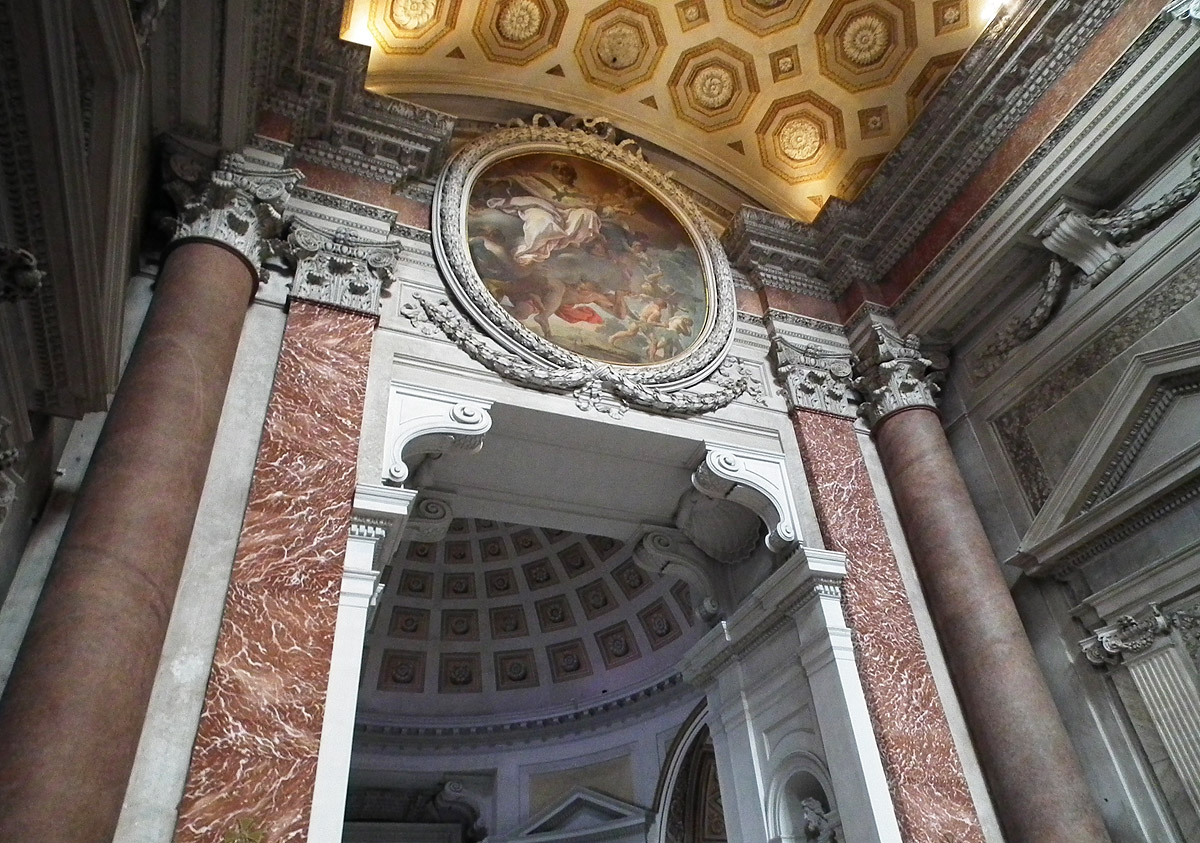 |
||
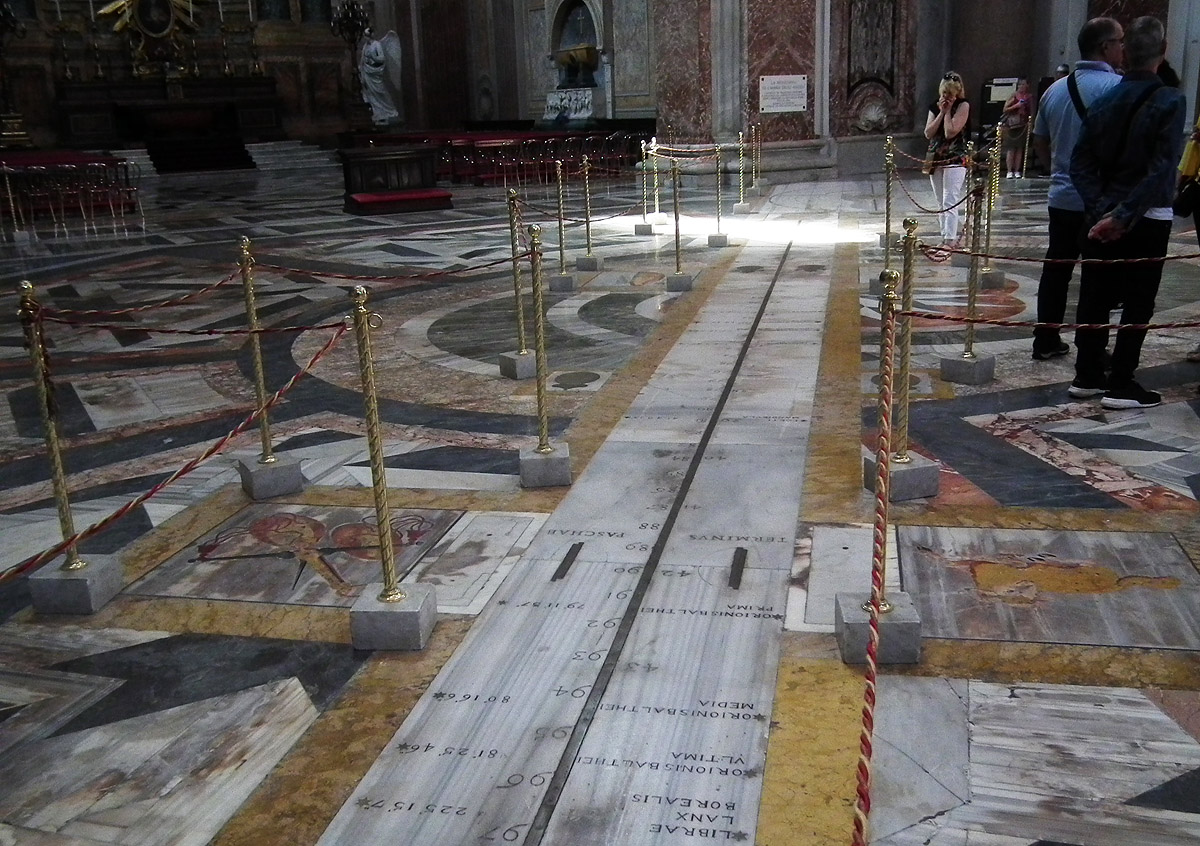 |
|||||
| In the Basilica Santa Maria degli Angeli e dei Martiri, there is a Meridian Line. Let Wikipedia explain:
|
Bianchini's sundial was built along the meridian that crosses Rome, at longitude 12° 30' E. At solar noon, which varies according to the equation of time from around 10:54 a.m. UTC in late October to 11.24 a.m. UTC in February (11:54 to 12:24 CET),[2] the sun shines through a small hole in the wall to cast its light on this line each day. At the summer solstice, the sun appears highest, and its ray hits the meridian line at the point closest to the wall. At the winter solstice, the ray crosses the line at the point furthest from the wall. At either equinox, the sun touches the line between these two extremes. The longer the meridian line, the more accurately the observer can calculate the length of the year. The meridian line built here is 45 meters long and is composed of bronze, enclosed in yellow-white marble. In addition to using the line to measure the sun's meridian crossing, Bianchini also added holes in the ceiling to mark the passage of stars. Inside the interior, darkened by covering the windows, Polaris, Arcturus and Sirius were observed through these holes with the aid of a telescope to determine their right ascensions and declinations. The meridian line was restored in 2002 for the tricentenary of its construction, and it is still operational today." |
||||
 |
|||
| The elliptical section of the Meridian Line. | |||
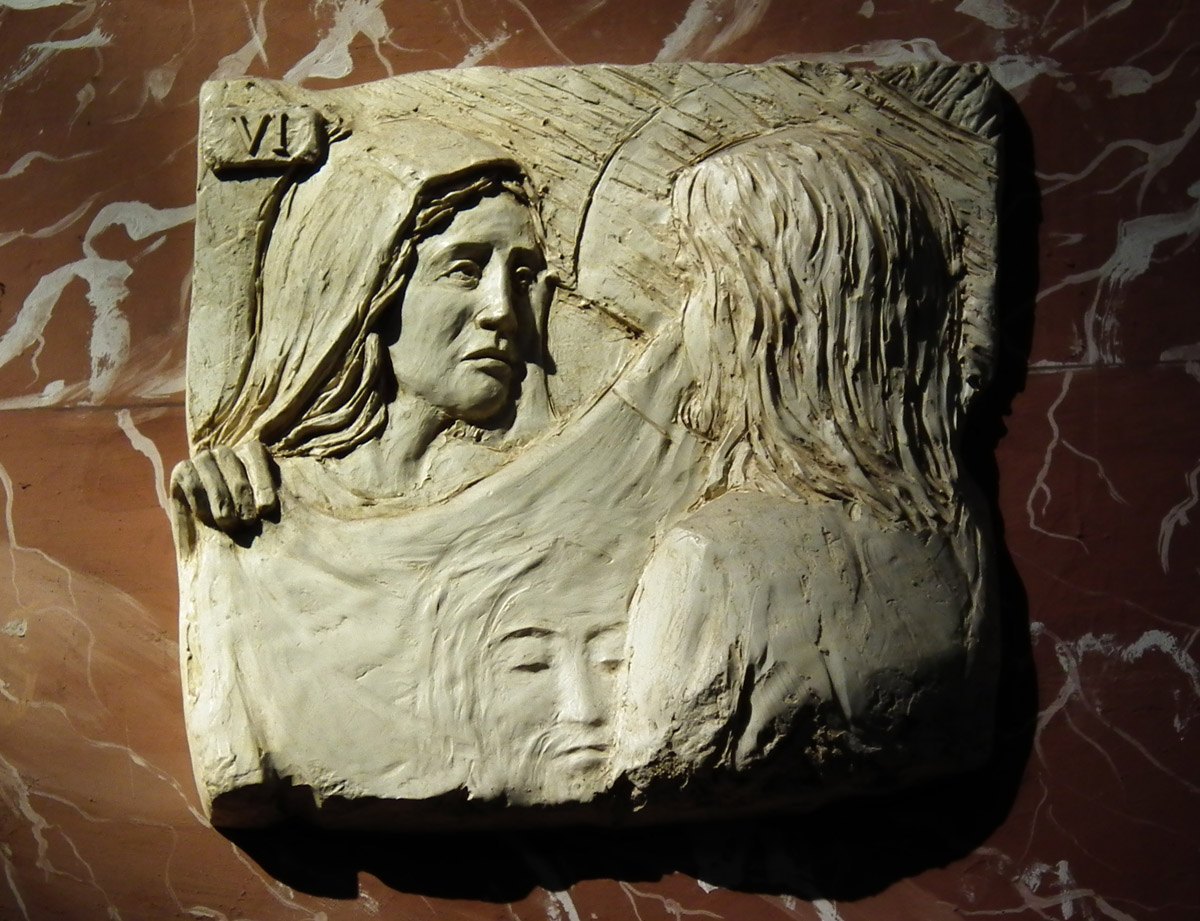 |
|||
| This is one of the Fourteen Stations of the Cross in the Basilica. | |||
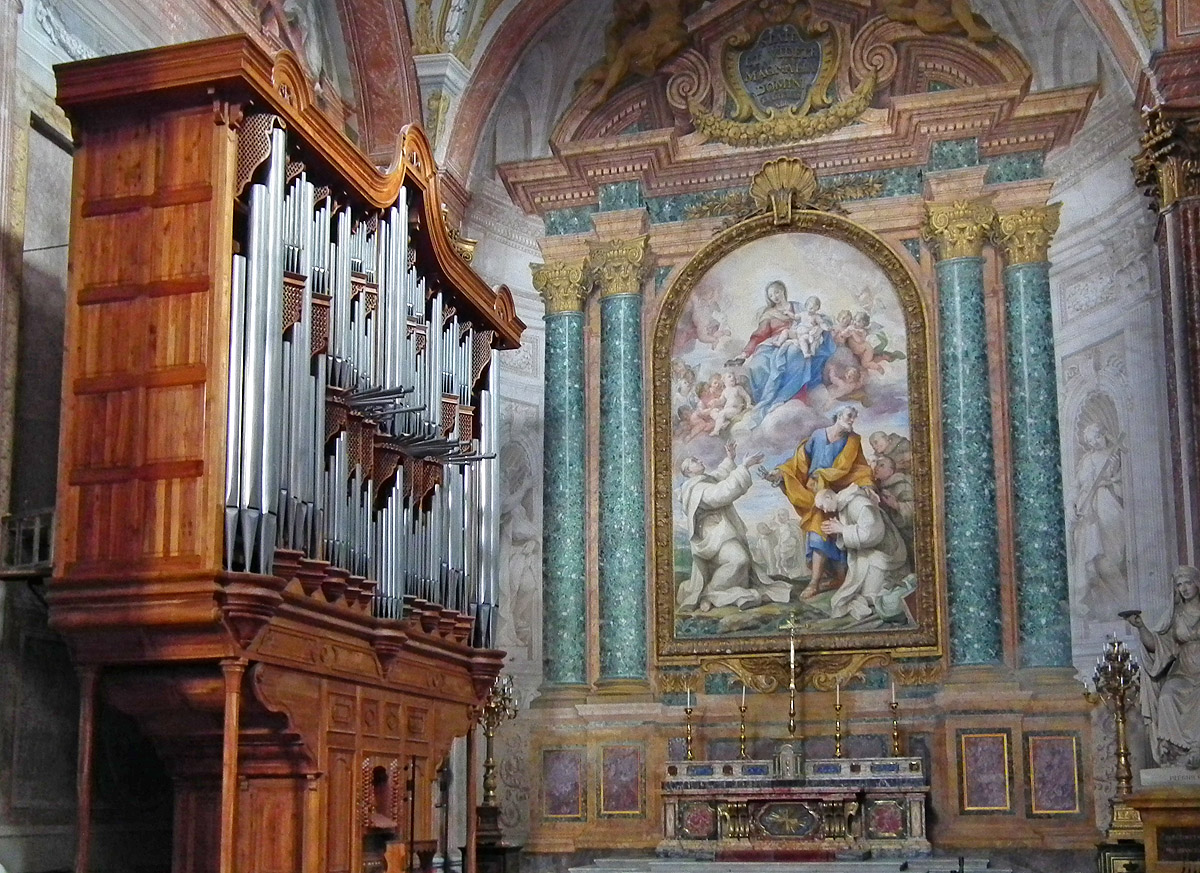 |
||
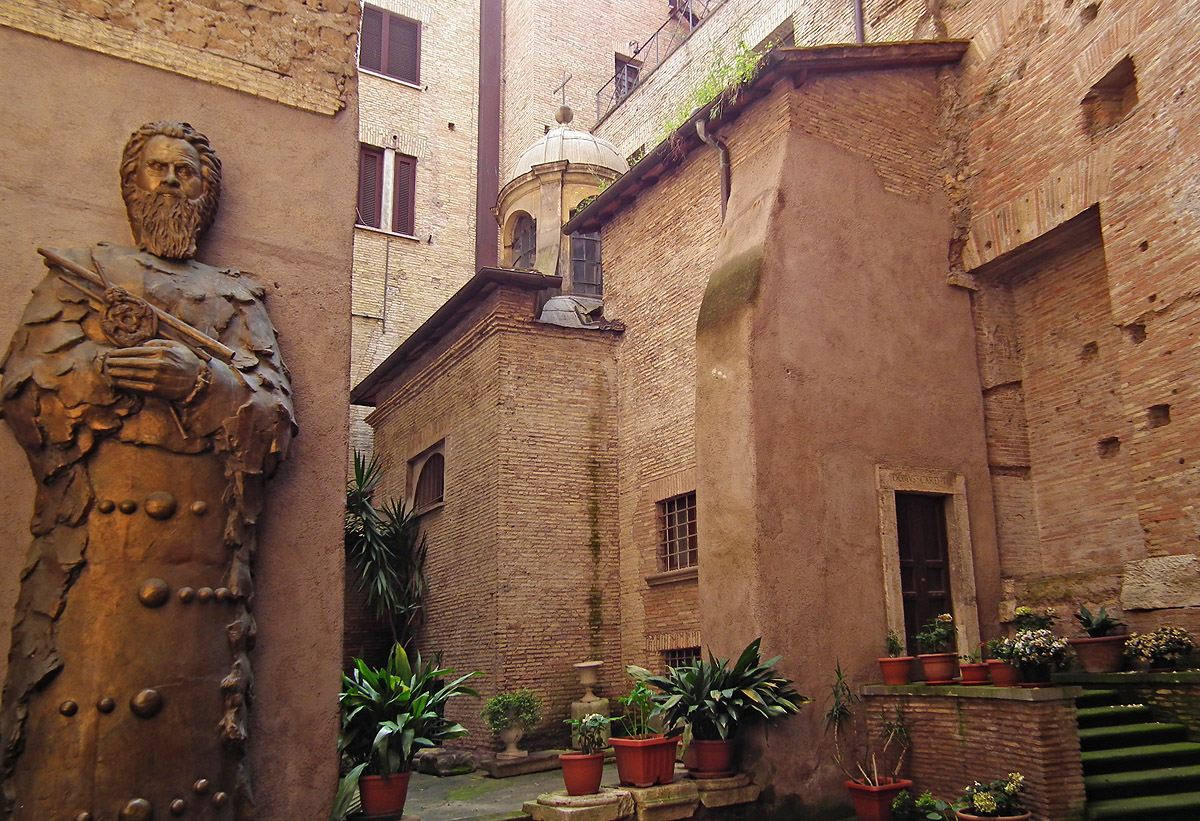 |
|||
| At the back of the Basilica, we can see traces of the old Diocletian Baths. | |||
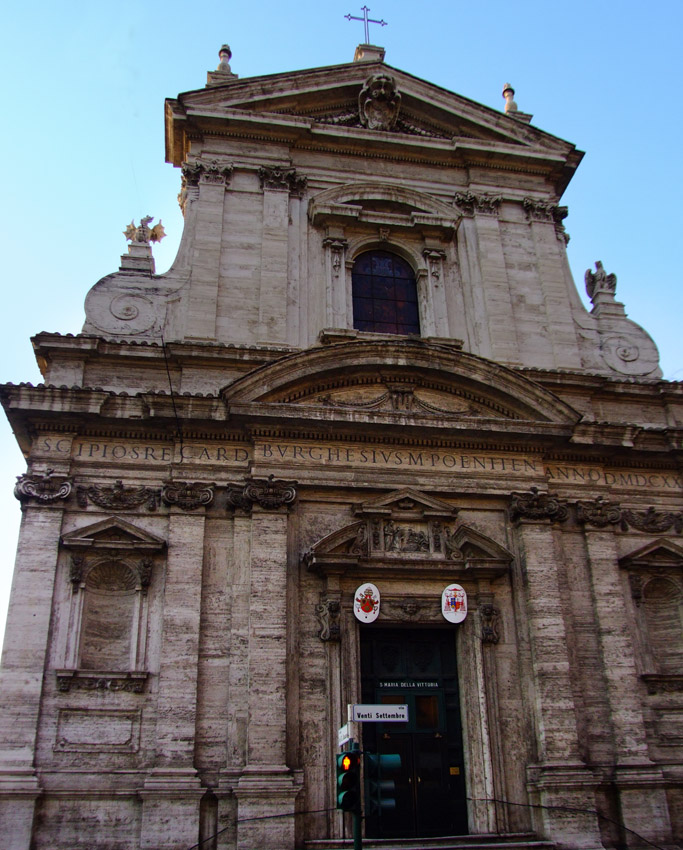 |
||||
| While we are in the neighborhood of the Roma Termini, it would be a cultural crime not to visit three lovely Churches... the Chiesa di Santa Maria della Vittoria, the Basilica Papale di Santa Maria Maggiore, and the Basilica di San Pietro in Vincoli.
We start with the Chiesa di Santa Maria della Vittoria, which is on the Via Venti Settembre. |
||||
 |
|||
| This is an over-the-top Baroque Church. | |||
 |
||||
| The baroque ceiling of the Chiesa Santa Maria della Vittoria. | ||||
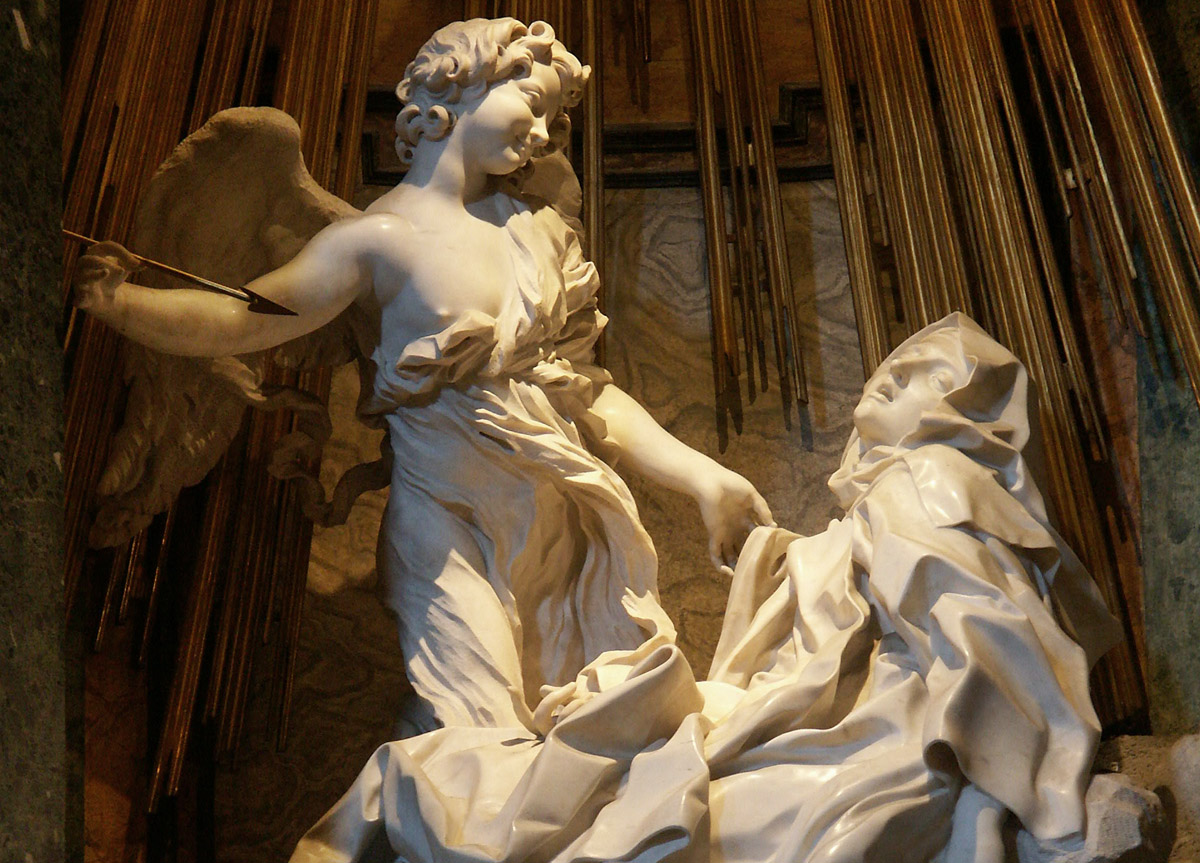 |
|||
| The jewel in the Baroque Crown of this Church is the statue of "The Ecstasy of Saint Teresa" by Bernini.
The female subject of the sculpture was Teresa of Avila in Spain. Throughout her life she suffered greatly from periods of painful religious ecstasy. |
|||
 |
|||
| A short walk Westwards from Roma Termini brings us to the majestic Basilica Papale di Santa Maria Maggiore.
It is the largest Catholic Marian Church in Rome which is why it deserves the title "major". |
|||
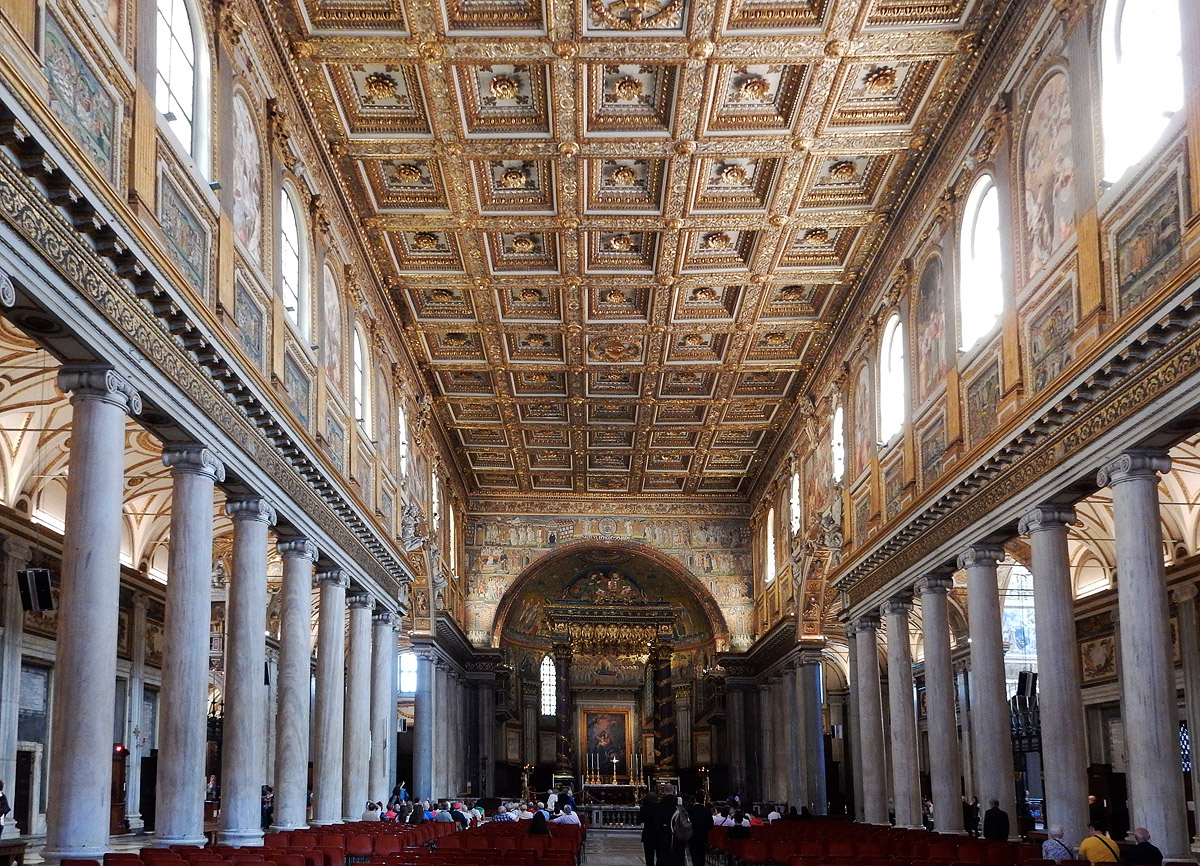 |
|||
| The Ionic columns of the Nave lead our eyes to the Altar of the Basilica. | |||
 |
|||
| Looking up at the painted dome of the Basilica. | |||
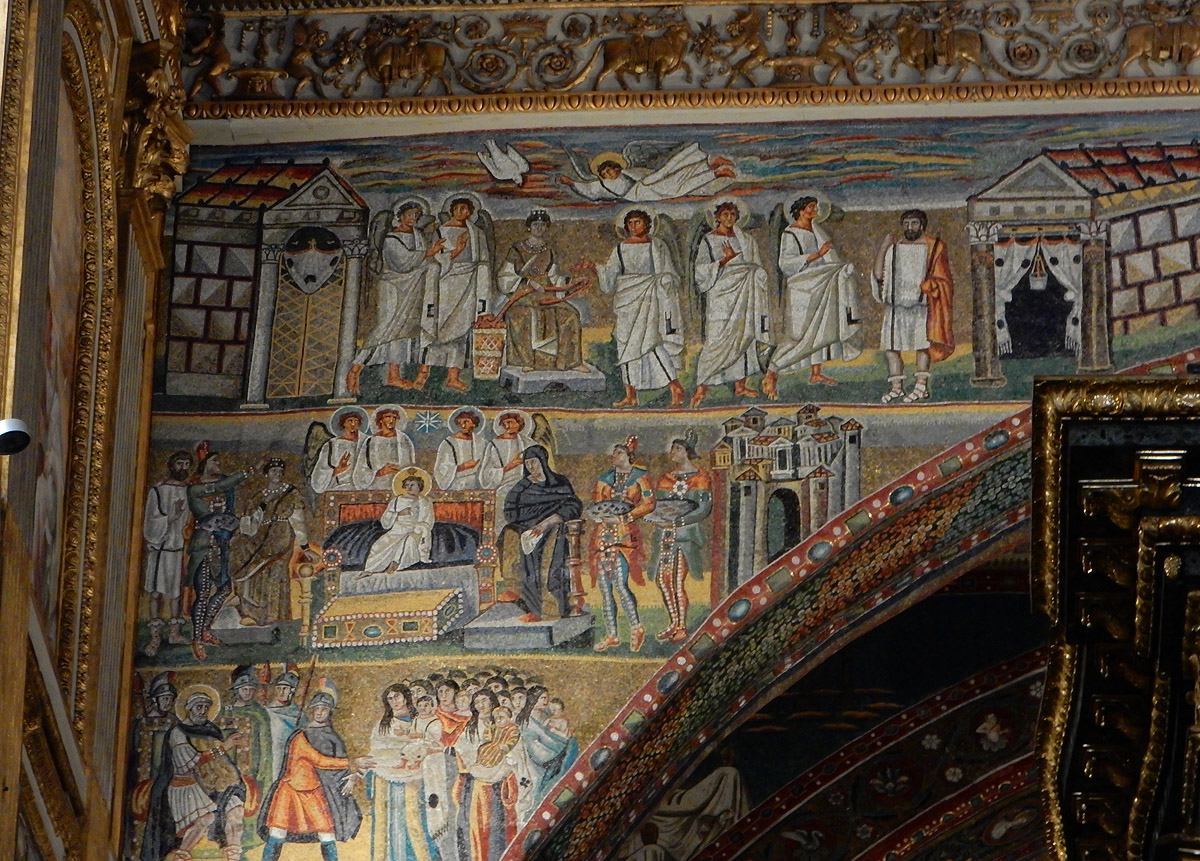 |
|||
| I think this Basilica may have the most mosaics in Rome. | |||
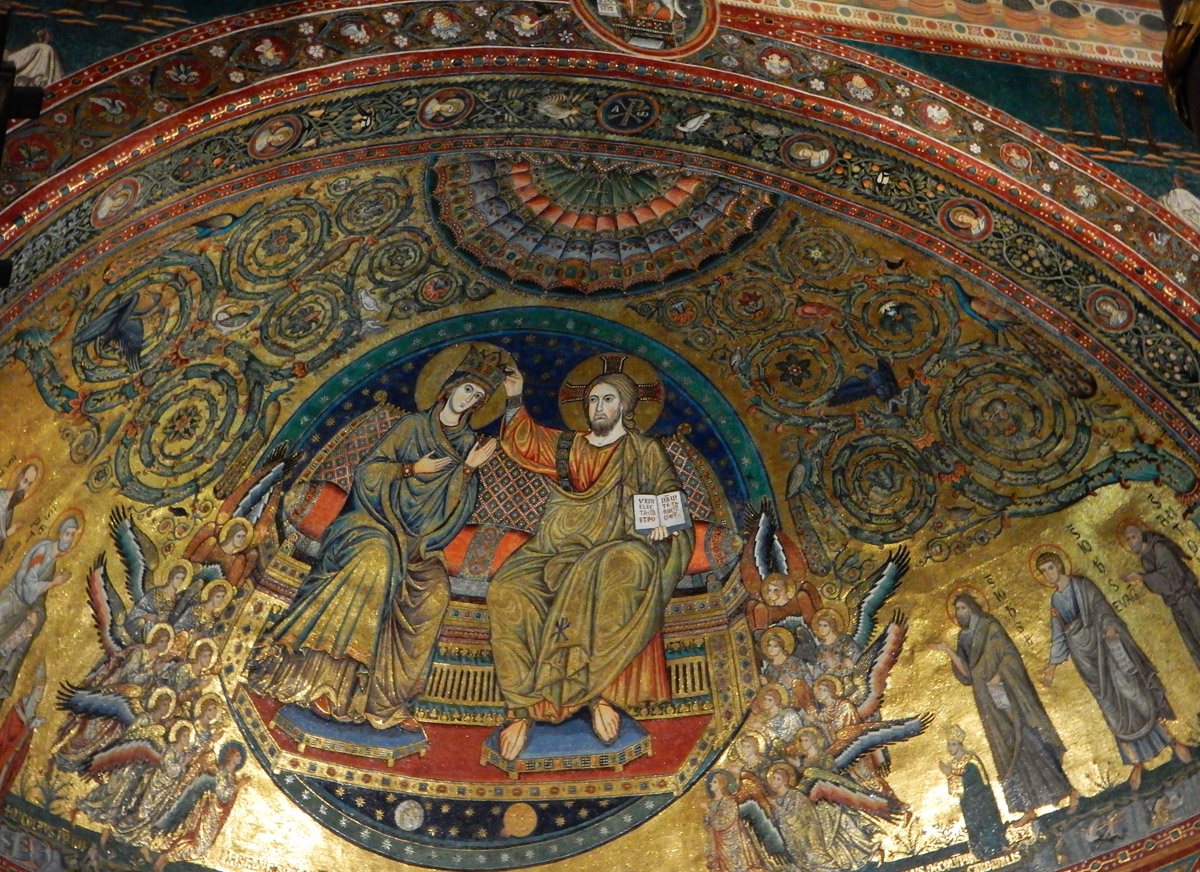 |
|||
| Christ crowning Mary in Heaven. | |||
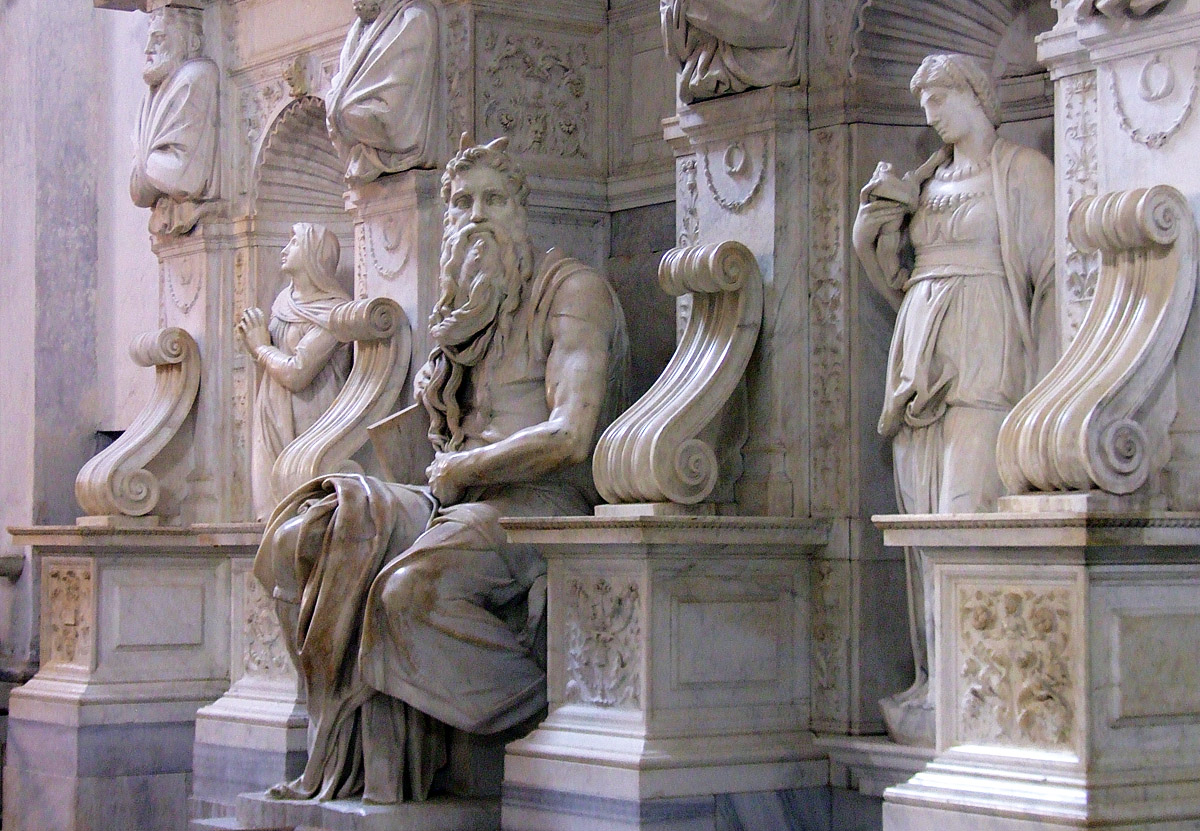 |
|||
| We now walk further West till we reach the Basilica di San Pietro in Vincoli (Saint Peter in Chains).
This Basilica may not be the prettiest in town but it has one thing which may attract the serious tourist... the "Moses" by Michelangelo. |
|||
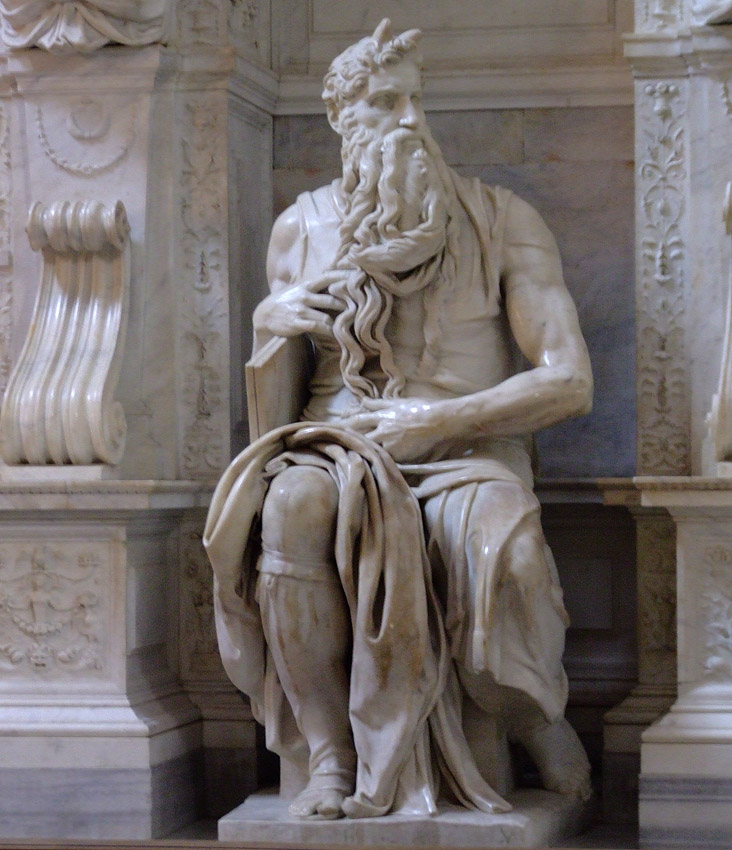 |
||
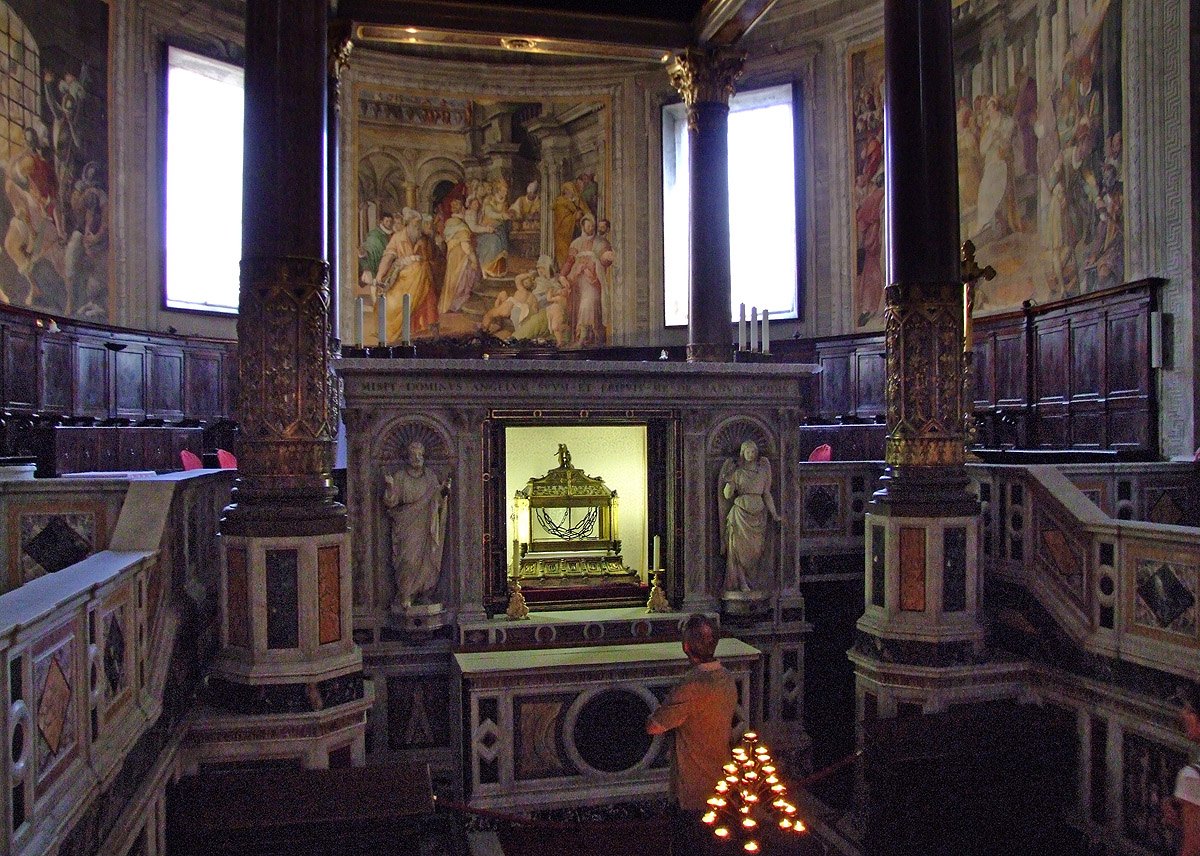 |
|||
| The chains of Saint Peter are enshrined in a glass case in the Basilica di San Pietro in Vincoli. | |||
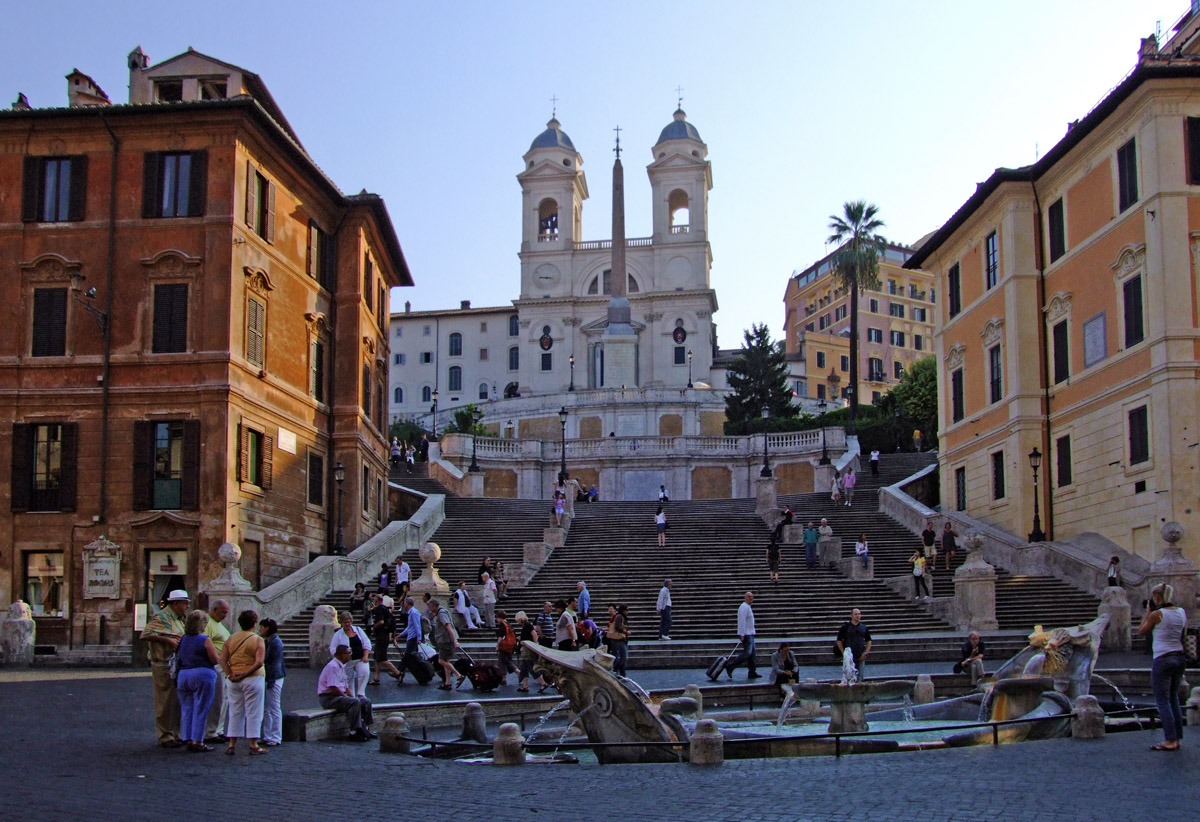 |
|||
| The famous Spanish Steps in Rome were created in 1725. There had been much discussion for years on how to connect the Piazza di Spagna below with the Church of Trinita dei Monti which we can see above. The steps were designed by Alessandro Specchi and Francesco De Sanctis. There are a total of 135 steps to the terrace above.
I must confess that I am cheating a little by using a photo which I took in 2009, before tourism went berserk in Rome. See the photo below for a view taken in 2018. |
|||
 |
|||
| This ia a view of the Spanish Steps taken in 2018 from a terrace on the middle of the hill. Whoops! | |||
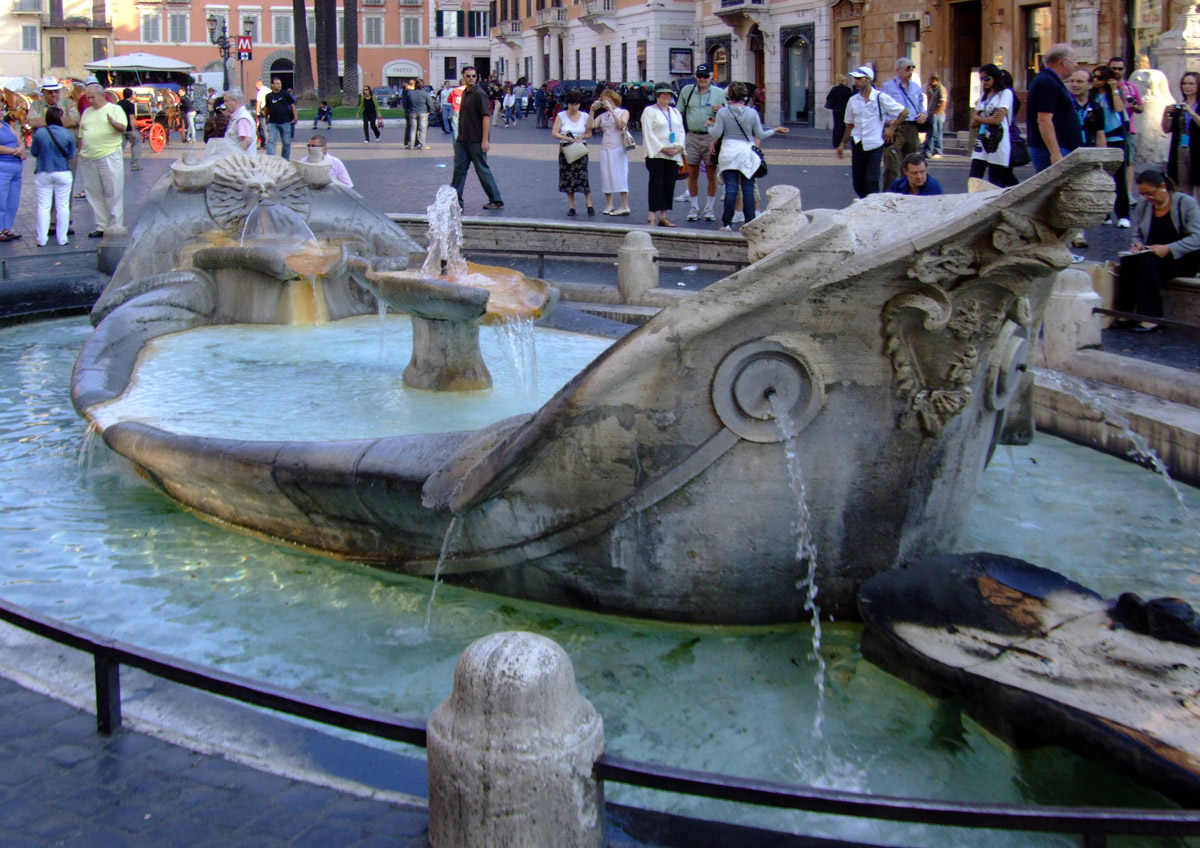 |
|||
| Piazza di Spagna. This is the Fontana della Barcaccia, which was sculpted by Pietro Bernini and his son, Gian Lorenzo Bernini. | |||
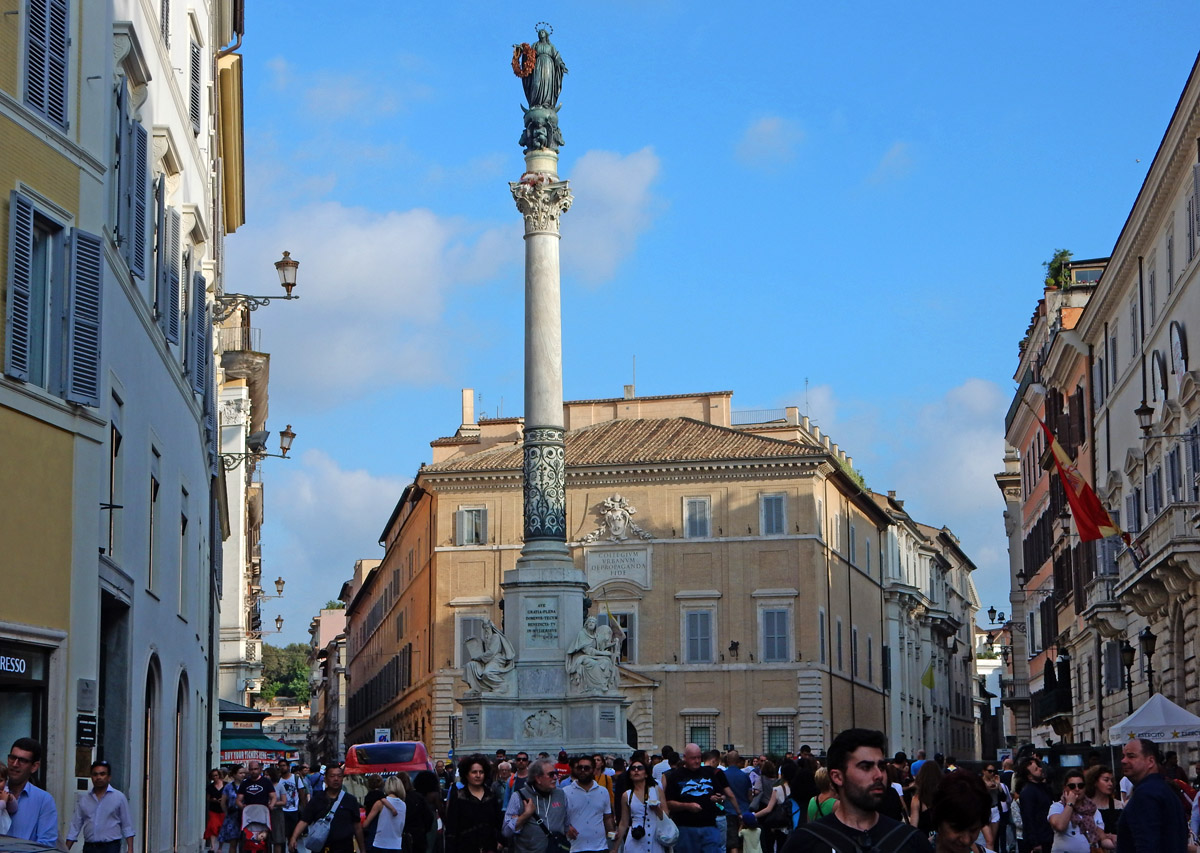 |
|||
| At the other end of the Piazza di Spagna, in an extension called the Piazza Mignanelli, is the Column of the Immaculate Conception, erected in 1856. The Corinthian column itself was sculpted in Ancient Rome and it once held a statue of the Goddess Minerva.
What is historically significant is that the placing of the Virgin Mary's statue atop the column came just a few years after the dogma of the "Immaculate Conception" was adopted by the Catholic Church in 1854. |
|||
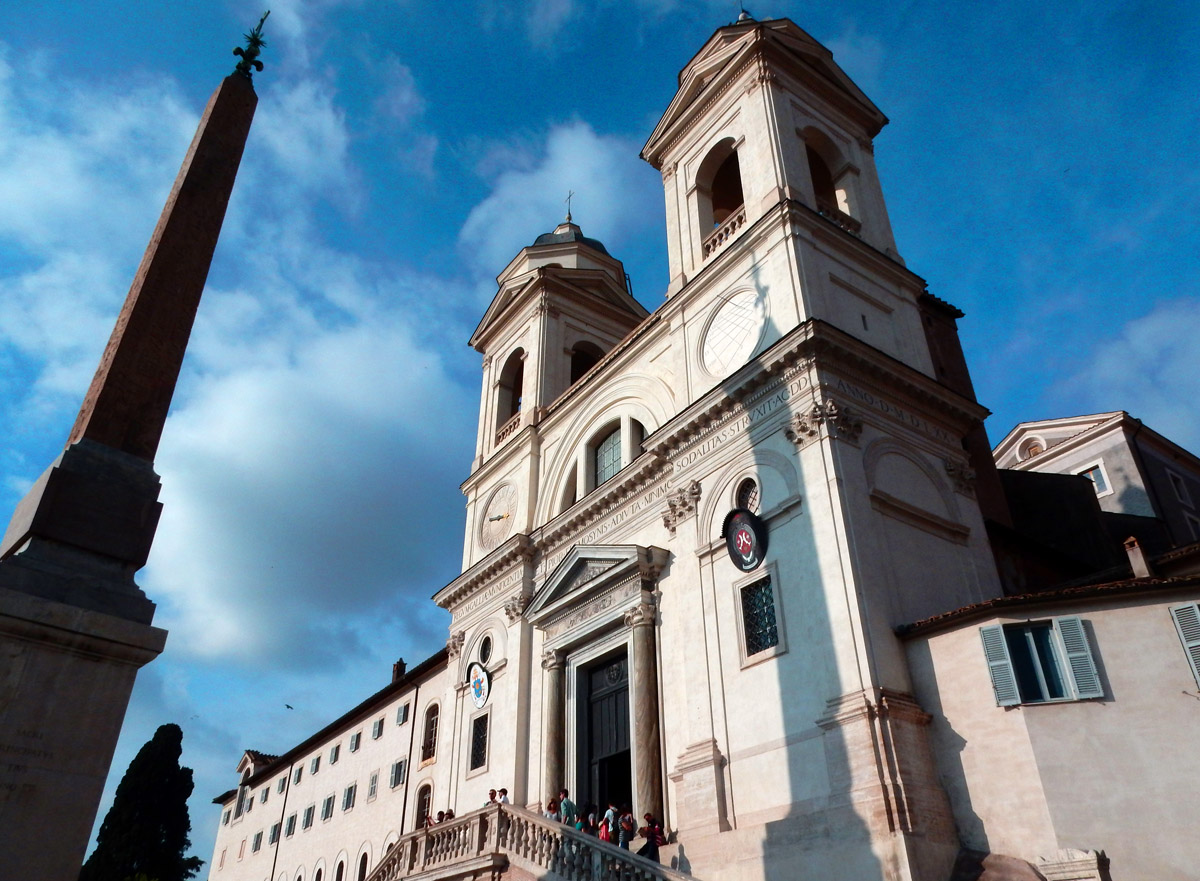 |
|||
| This is a close up shot of the Church of the Santissima Trinita dei Monti, at the very top of the Spanish Steps.
This Church has had a close link with France for centuries. Wikipedia states that in 2010 the Cardinal Priest of this Church was Philippe Barbarin, Archbishop of Lyon and Primate of the Gauls. |
|||
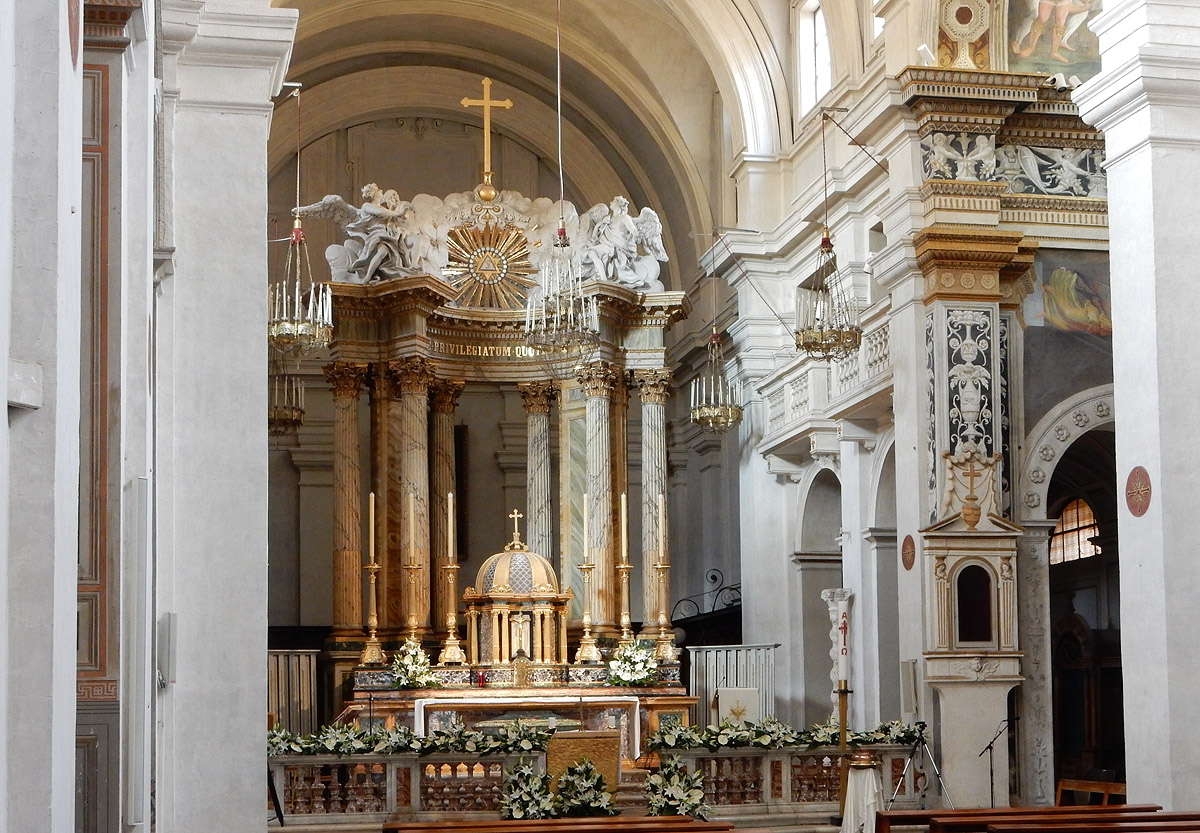 |
|||
| The Altar of the Trinita dei Monti. | |||
 |
|||
| This sculpture of "The Deposition of Christ" by Wilhelm Achtermann is in the Trinita dei Monti. | |||
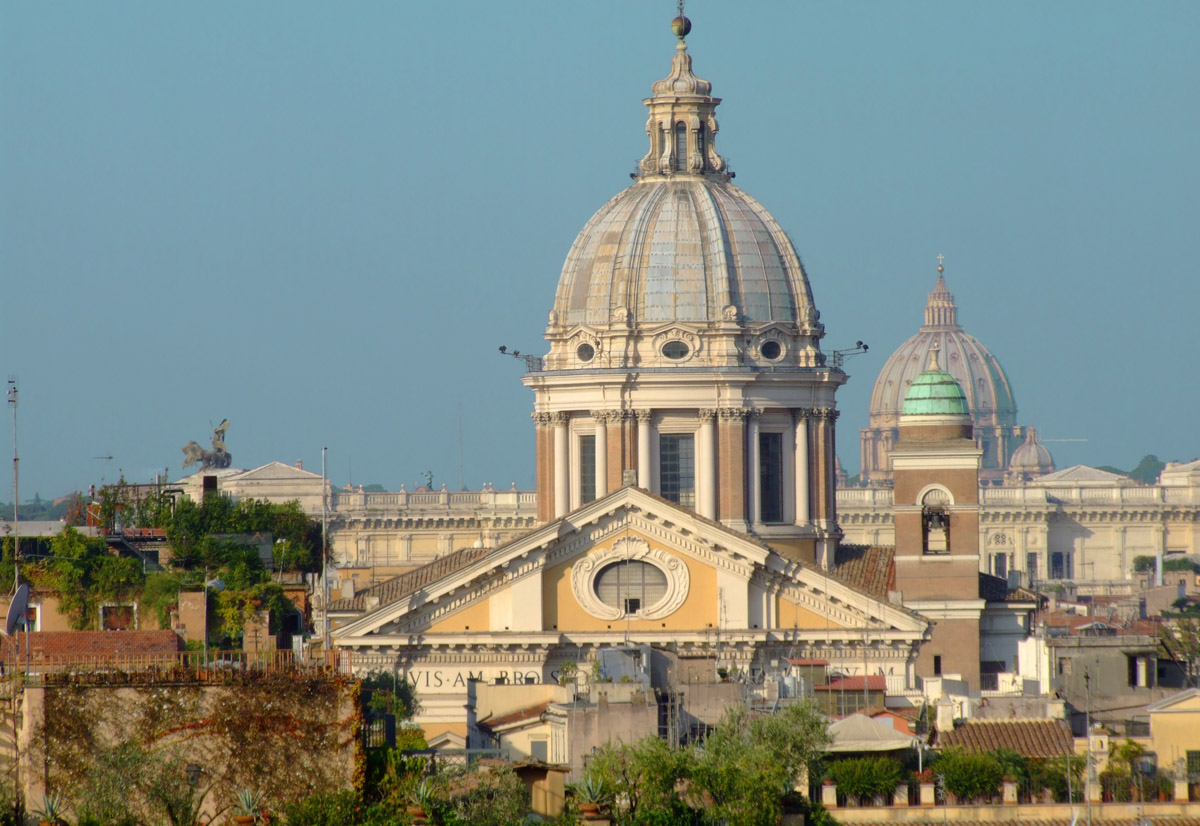 |
|||
| There are lovely views of Rome from the front steps of the Trinita dei Monti. | |||
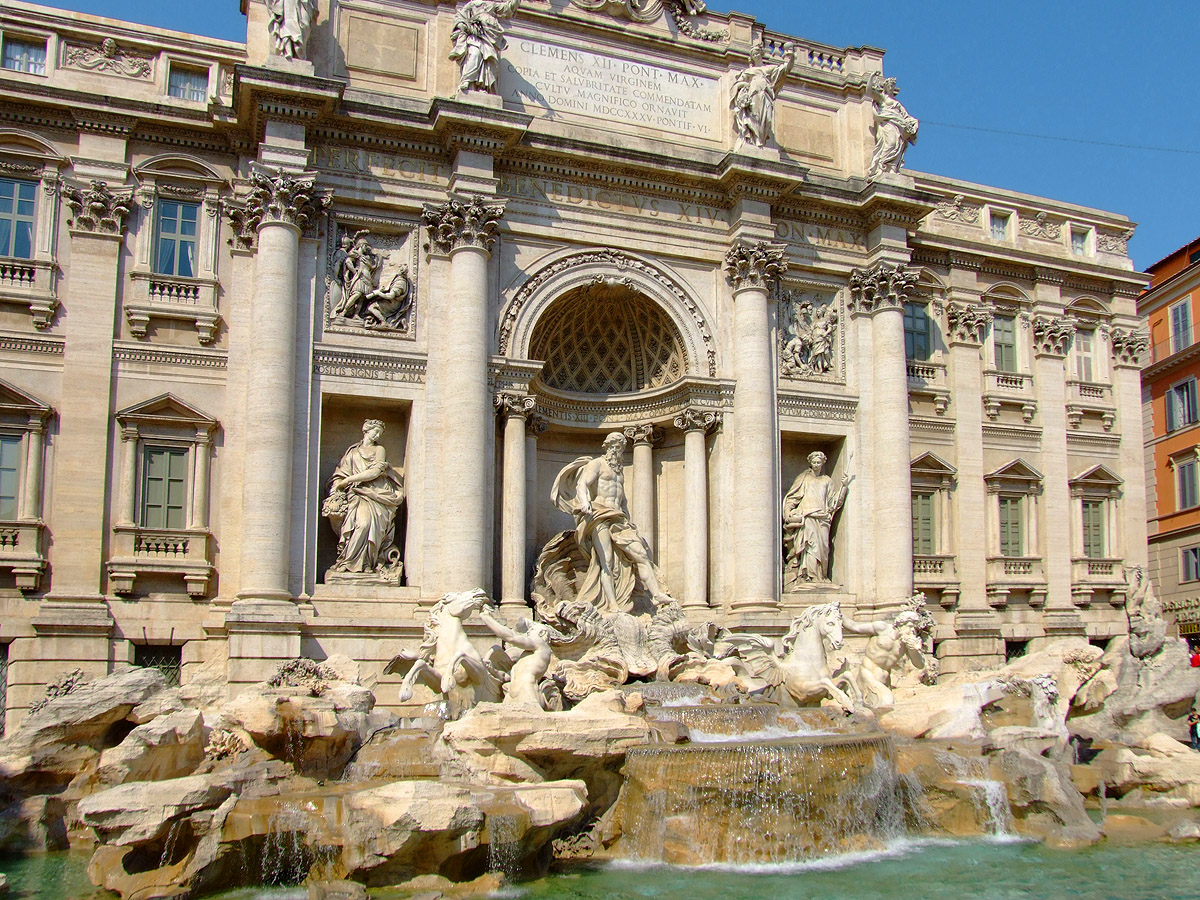 |
|||
| If we were to walk just 500 metres towards the South from Piazza di Spagna and the Spanish Steps, we would arrive at the Trevi Fountains.
If you listen carefully above the noise from the crowds of tourists, you may just hear Frank Sinatra crooning the words of the song "Three Coins in the Fountain". |
|||
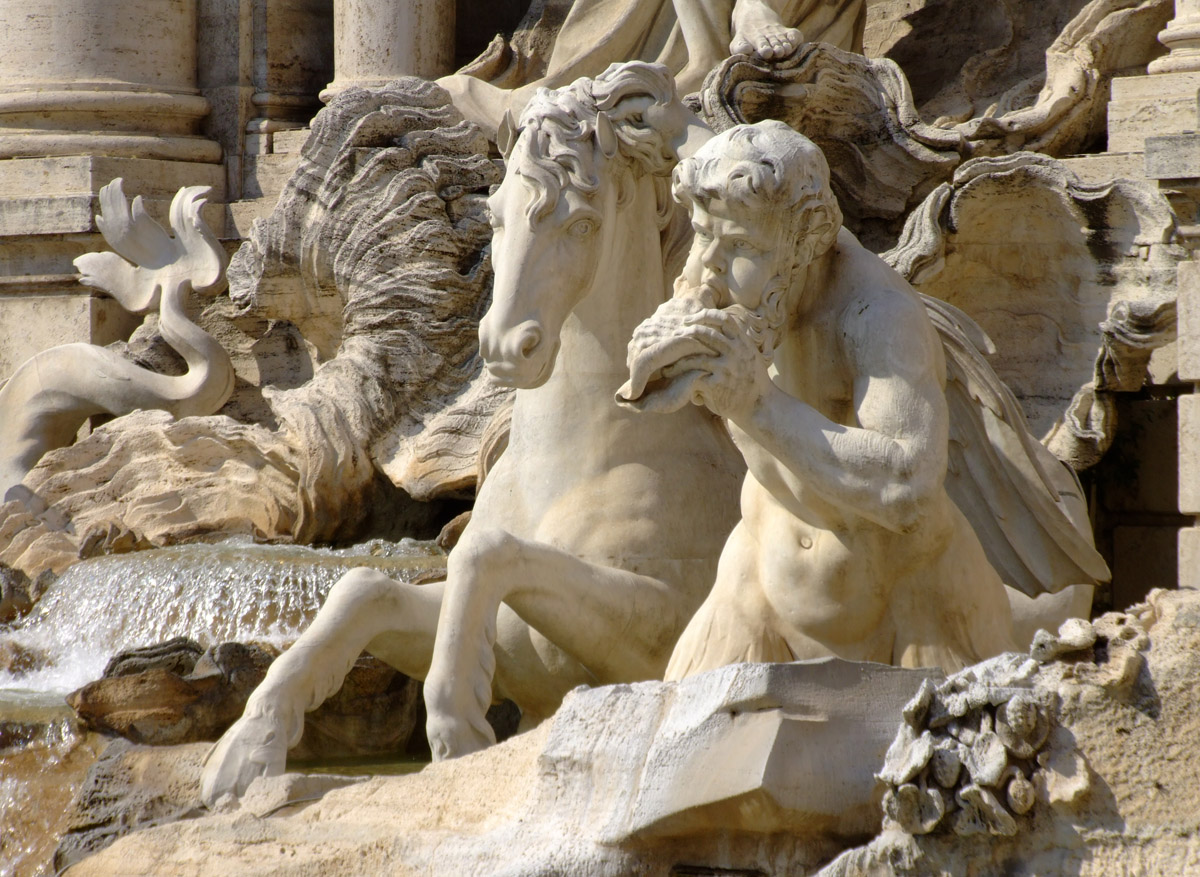 |
||
 |
|||
| The Fontana di Trevi. | |||
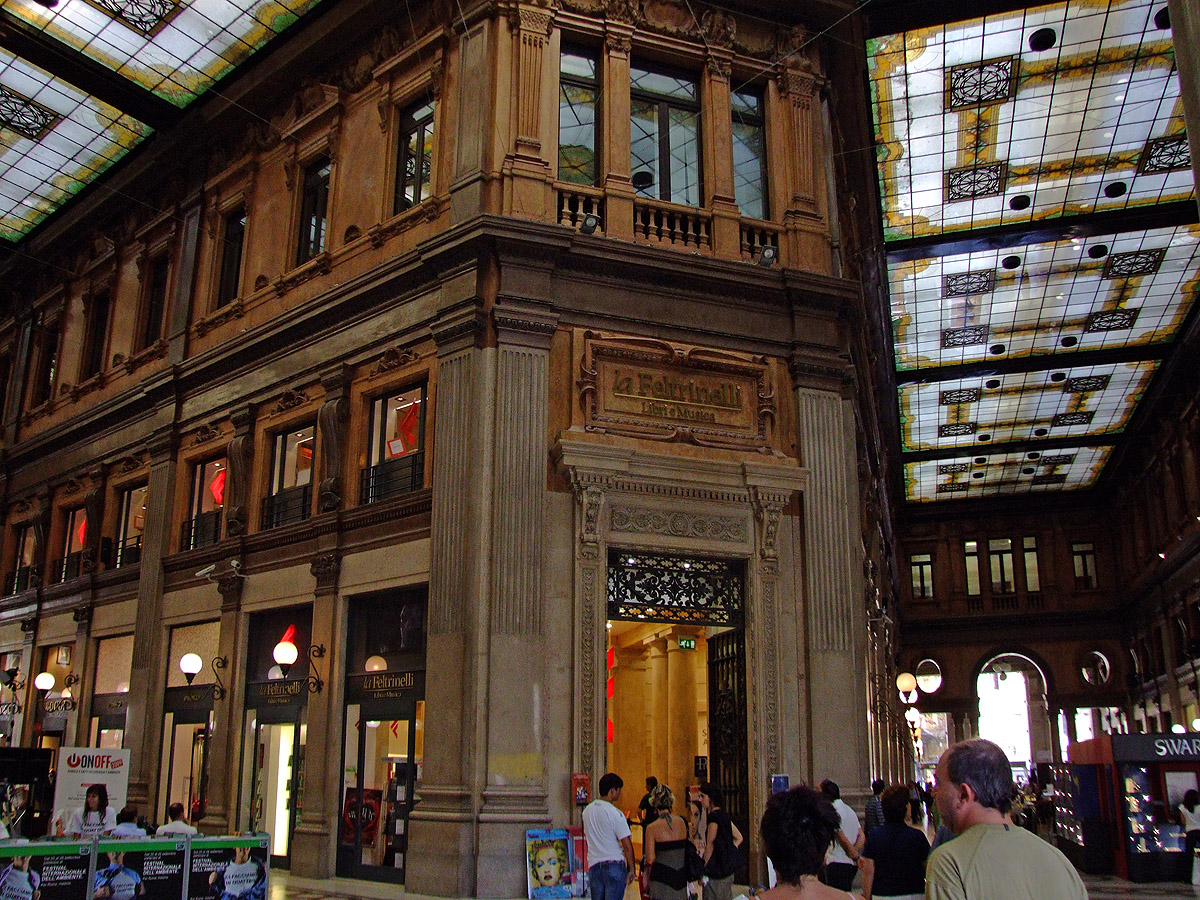 |
|||
| Not far from the Trevi Fountain, about 150 metres to the West, we come across a Shopping Mall called the Galeria Alberto Sordi.
When I first came to this Mall a few decades ago, I mentioned to a Barista who was making me a coffee that this Galleria reminded me of that famous Shopping Mall in Milan. "Yes", replied the Barista, with a grand Italian gesture," but OURS is OLDER!" |
|||
 |
||
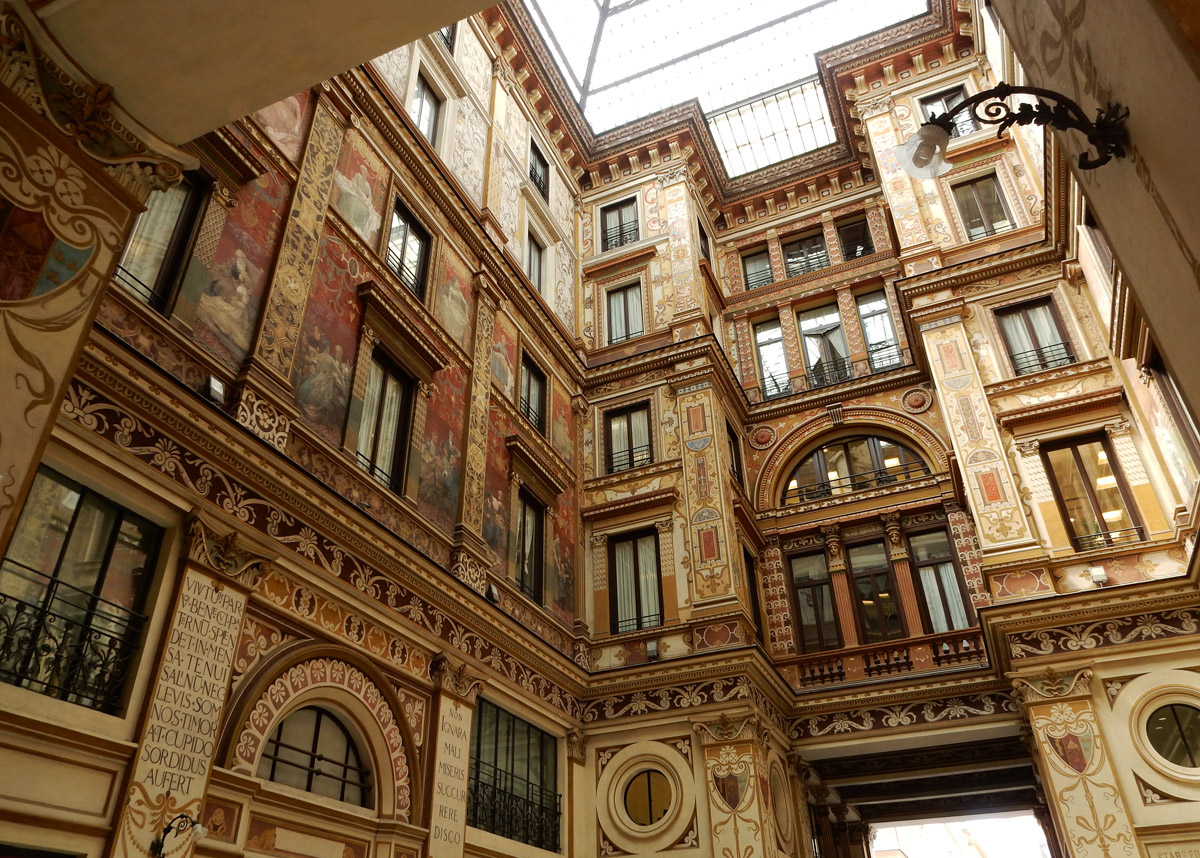 |
|||
| The Galleria Sciarra, in the Via Santa Maria in Via.
This was a surprise for me on my latest trip to Italy. It is only about 100 metres from the Trevi Fountain and yet I had not come across it before. It is another Shopping Mall, with the shops on five floors. This photo was taken in the central courtyard looking up towards the glass roof. |
|||
 |
|||
| The beautifully decorated inner walls of the Galleria Sciarra. | |||
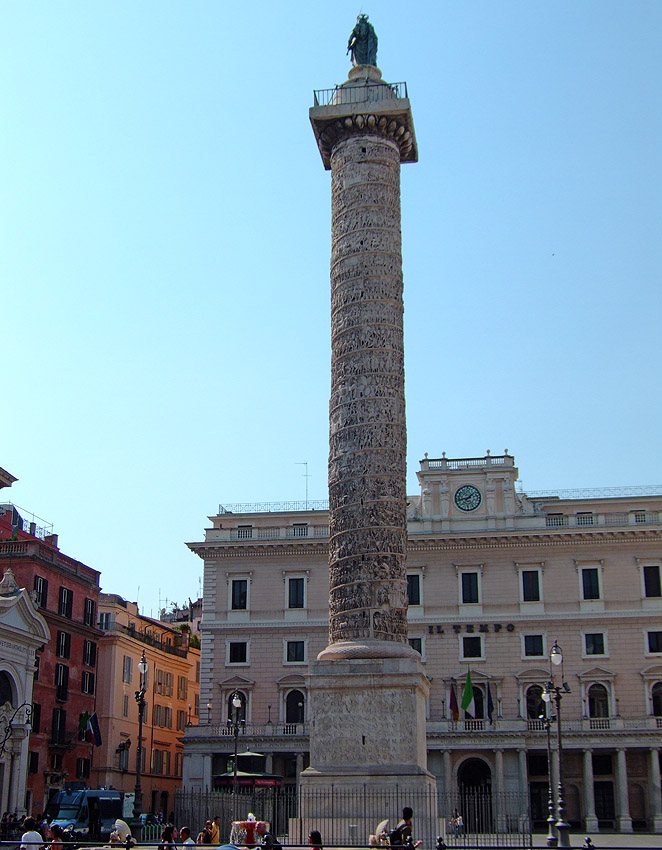 |
||||
| As we resume our walk Westwards, we come across a familiar sight in the Piazza Colonna. It is another giant column, this time commemorating the Emperor Marcus Aurelius, completed in 193 AD.
The statue now standing at the top of the column is that of Saint Paul, to complement the one of Saint Peter which is atop the Trajan Column. The column of Marcus Aurelius is made of 28 giant circular blocks of Carrara marble, each of 3.7 metres in diameter. The marble blocks were hollowed out in the quarry before being transported here, to allow the construction of an inner stairway to reach the top of the column. As in the Trajan Column, there are small slits carved into the marble to allow light to shine into the stairwell. |
||||
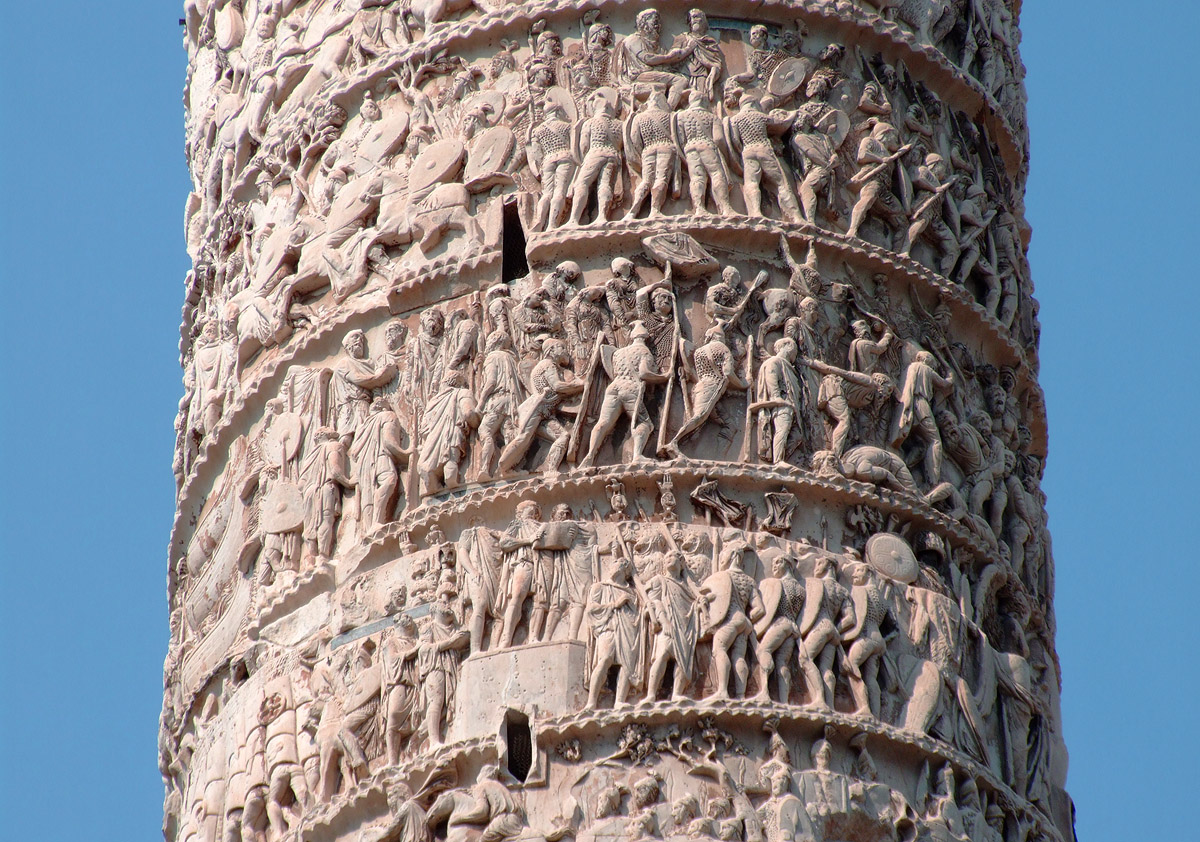 |
|||
| A close up shot of the Colonna di Marco Aurelio. There are two slits clearly visible to let in light into the inner stairwell. | |||
 |
|||
| Just around the corner from the Piazza Navona (which is the next destination on our walking tour), we see the facade of the Church of St. Louis of the French (San Luigi dei Francesi). The Church is dedicated to the Virgin Mary, to St. Denis the Areopagite, and to St. Louis IX, the King of France.
King Louis IX was canonised as both a Catholic and an Anglican saint. He was responsible for the building of such Gothic masterpieces as the Sainte-Chapelle in Paris. He was devoutly religious and he created new laws to punish crimes like blasphemy by the mutilation of tongues and lips. A thoroughly nice religious chap! San Luigi dei Francesi is the national church in Rome of France. It remains the property and responsibility of the French Government. What makes it even more special is that it houses three paintings by Caravaggio. |
|||
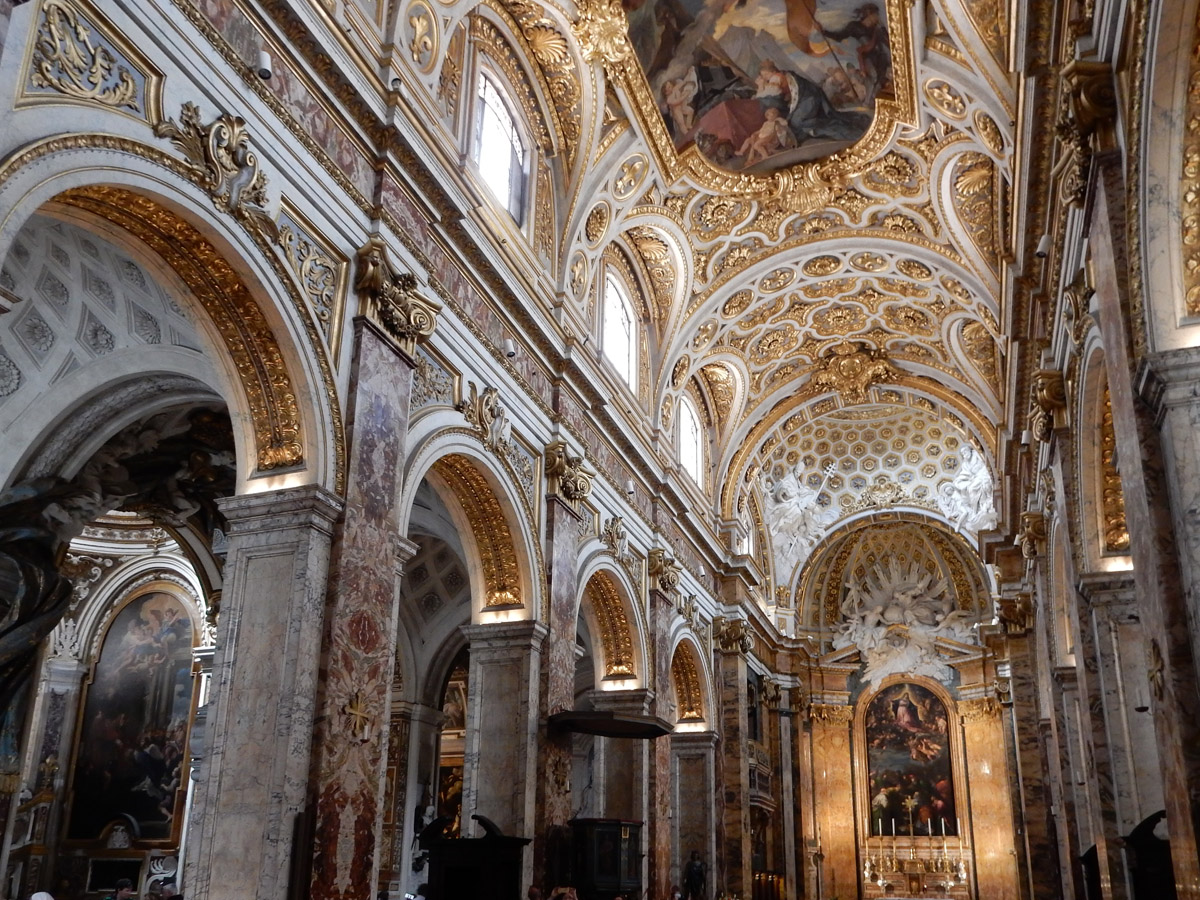 |
|||
| The nave looking towards the altar. Above the altar is a painting by Caravaggio, "The Inspiration of Saint Matthew". | |||
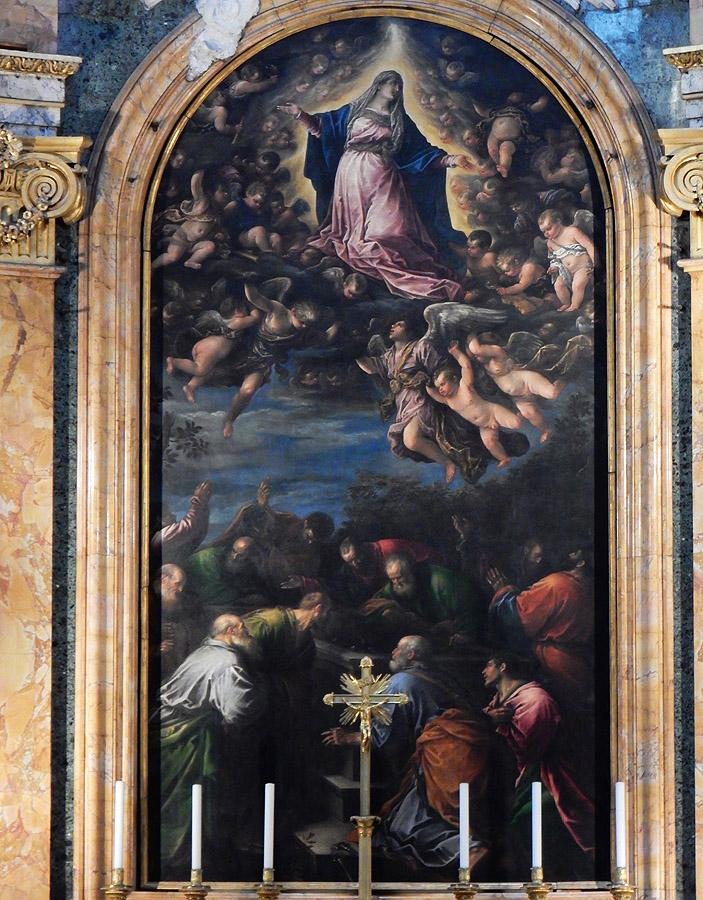 |
||||
| "The Inspiration of Saint Matthew" by Caravaggio. | ||||
 |
|||
| The top half of the "Inspiration of Saint Matthew". | |||
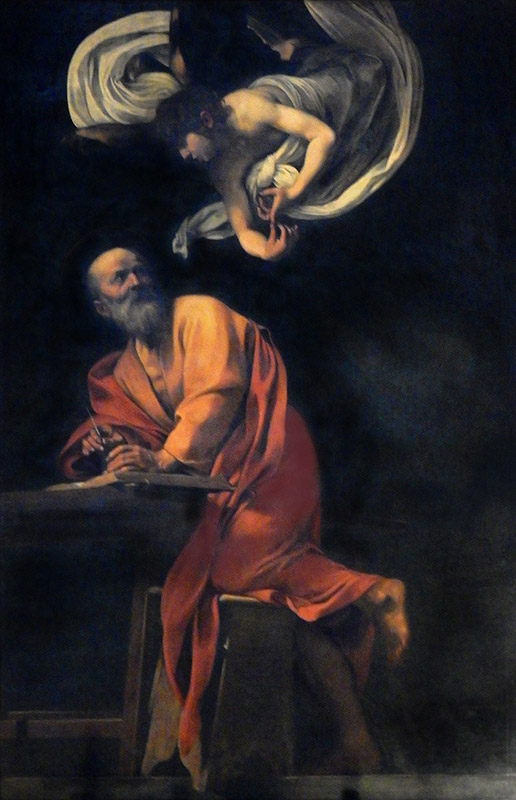 |
||||
| "The Calling of Saint Matthew", by Caravaggio. | ||||
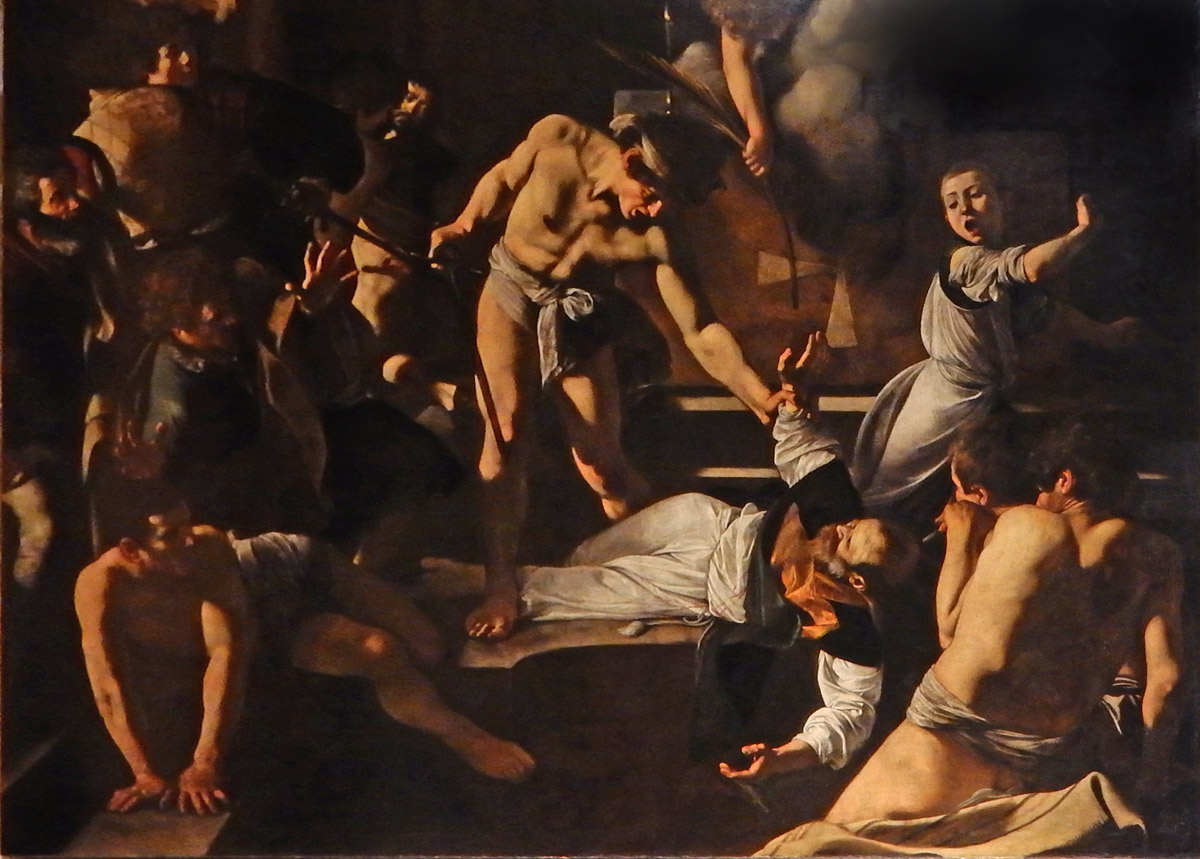 |
||||
| The bottom part of "The Martyrdom of Saint Matthew" by Caravaggio.
This painting is in a side chapel which could not be entered and so the photo was taken at an extreme angle from the Nave. I had to use Photoshop to rearrange the shape and proportions of the image to make it legible. The light from above made the top section unreadable, so I had to crop the painting a bit. This is the lower half of Caravaggio's work. Just to the right of this text box we can see the perspective distortions in the original photo from which the above image emerged. |
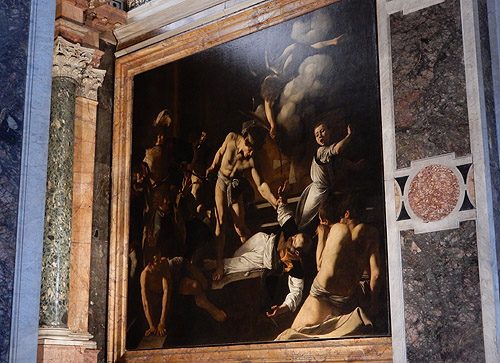 |
|||
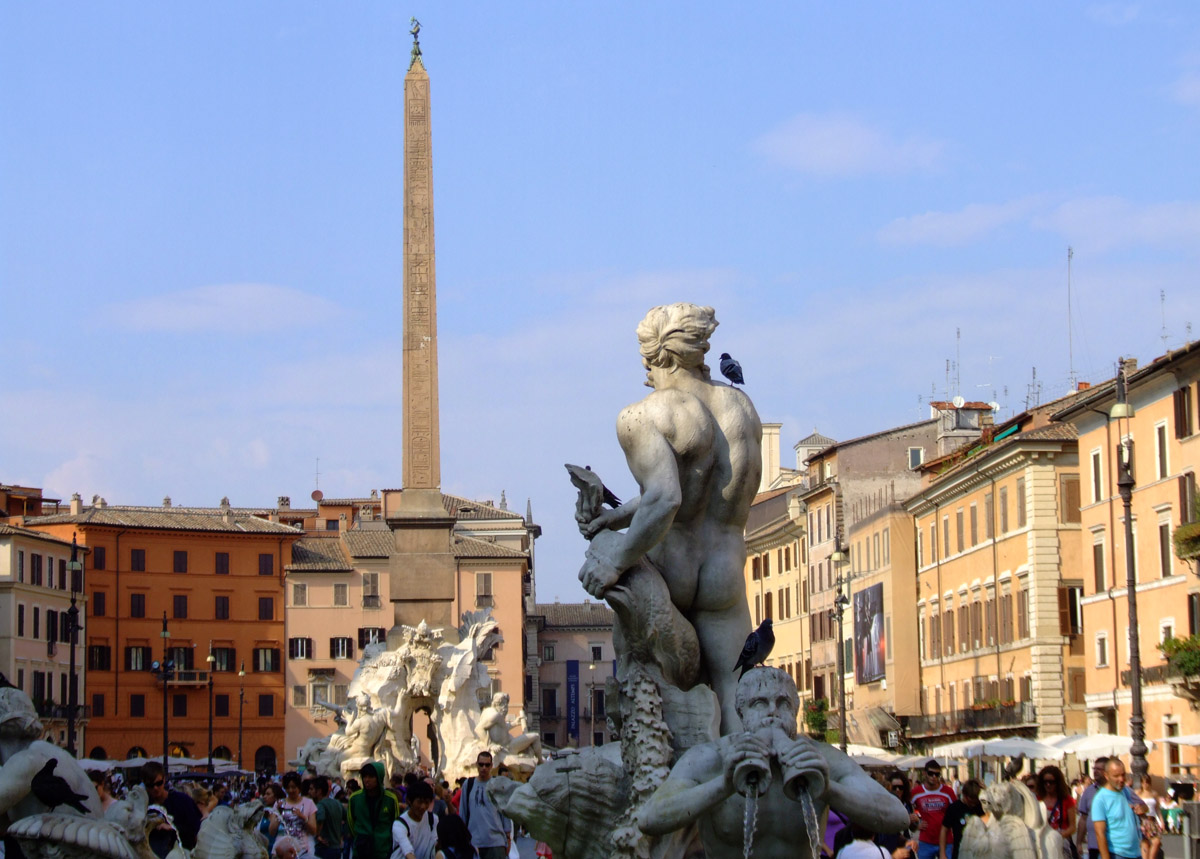 |
|||
| The Piazza Navona was created in the 17th Century and it occupied the space where once stood the Stadium of Domitian, which was built in the 1st Century AD. This is where the Ancient Romans came to watch the games (agones). It is now a very popular square. | |||
 |
|||
| This is the Fontana del Moro in the Piazza Navona.
The four Tritons surrounding it were sculpted by Giacomo della Porta and the tall statue of a Moor wrestling with a dolphin in the centre of the fountain was sculpted by Bernini. |
|||
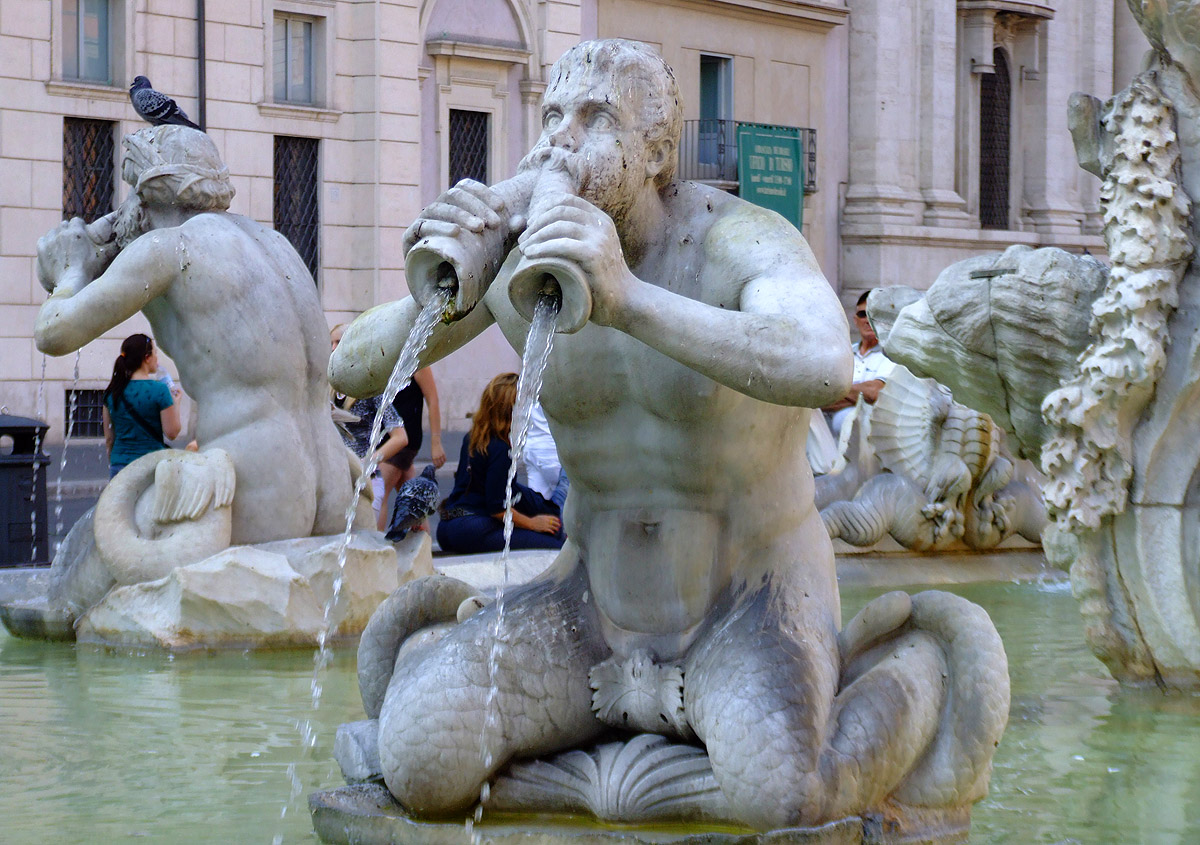 |
|||
| Triton was a mythological Greek god. He was the son of Poseidon and Amphitrite, who were the god and goddess of the sea. Thus Triton is often depicted as a merman, half human and half fish. | |||
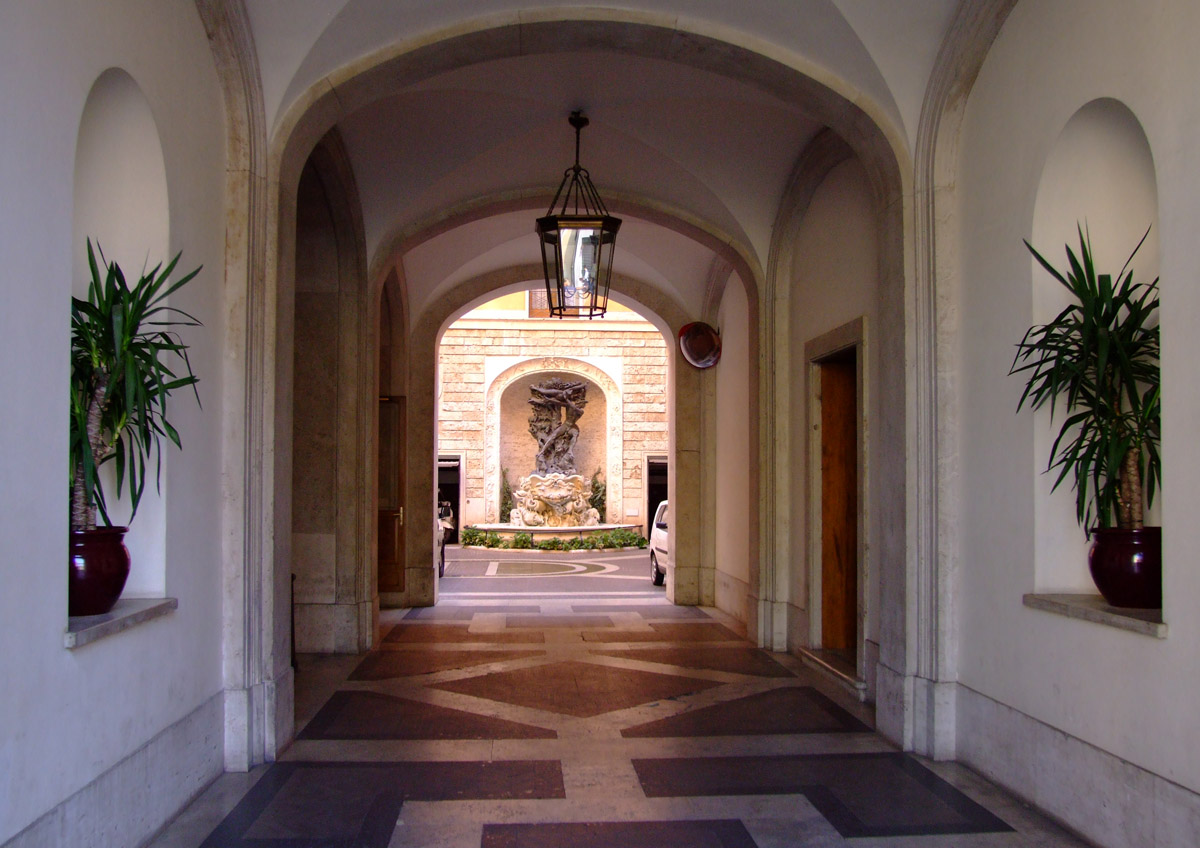 |
|||
| As we wander through the streets of Rome we should keep an eye out for little corners of the city worth examining. Here is an entrance into a private courtyard which has space for parking a car or two, a most valuable thing to possess in Rome! | |||
 |
|||
| When we want to escape from the hustle and bustle of this busy city, we can head to one of a number of beautiful and serene parks.
This is in the Villa Borghese which is just to the North of the Spanish Steps. It is my favourite park in Rome. |
|||
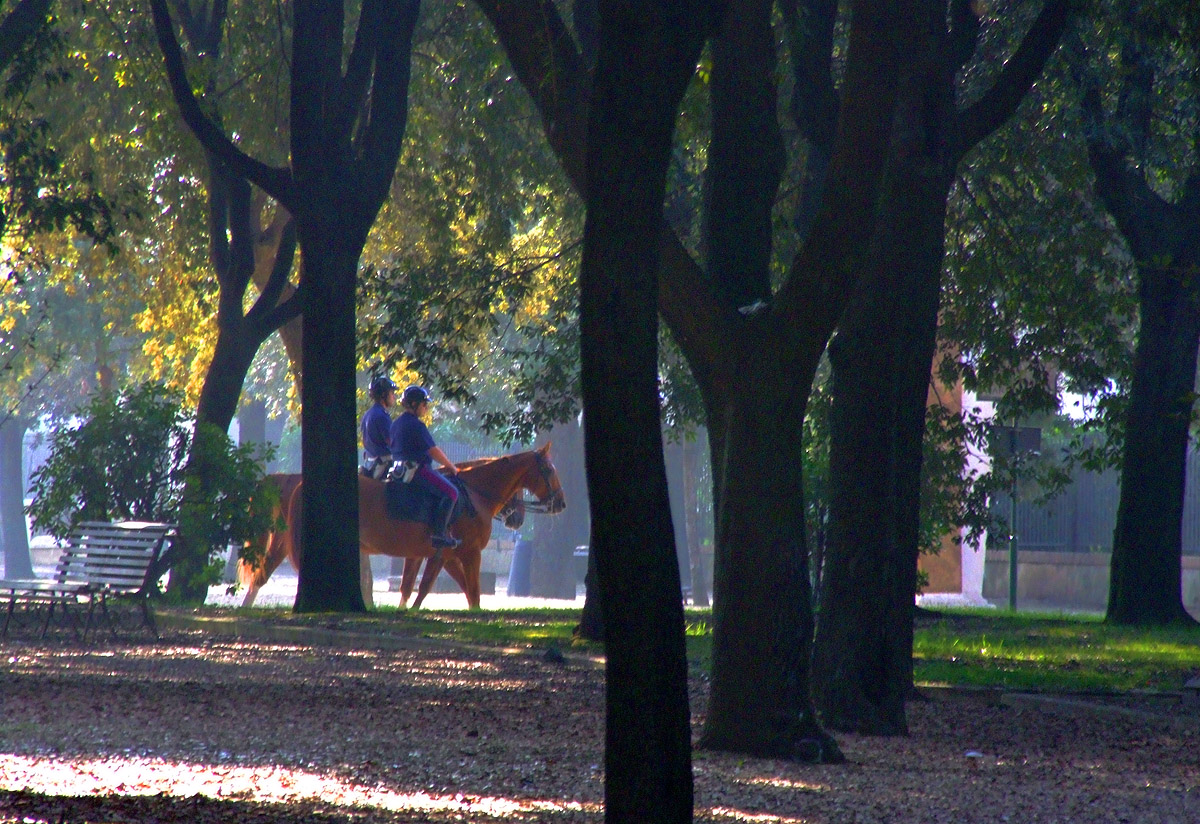 |
||
 |
|||
| In the Villa Borghese. | |||
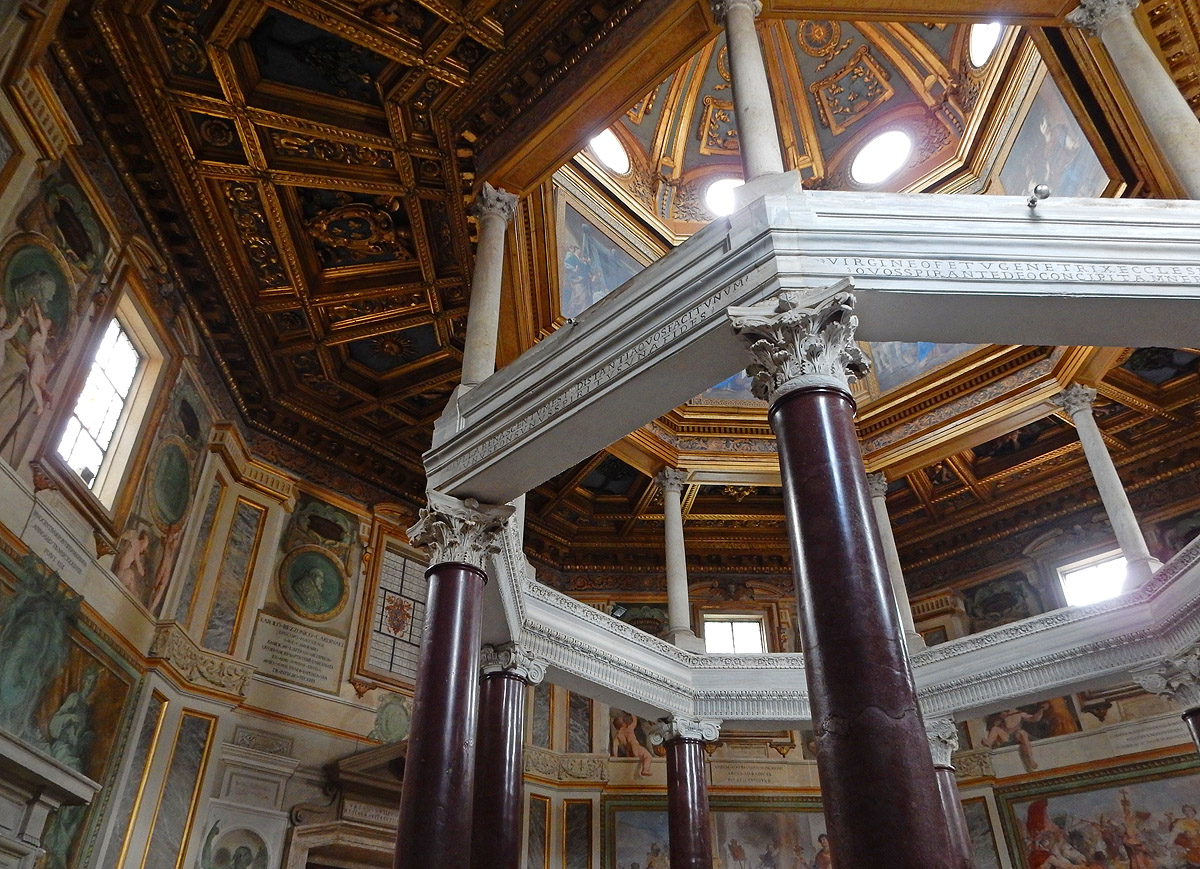 |
|||
| We end our tour of Rome with two distinctive churches. They are situated in the Laterano district which is located about 500 metres South of the Roma Termini.
The Church in the photo above dates back to the time of Constantine in the 4th Century AD. It is called the Lateran Baptistery and its full title is San Giovanni in Fonte al Laterano. |
|||
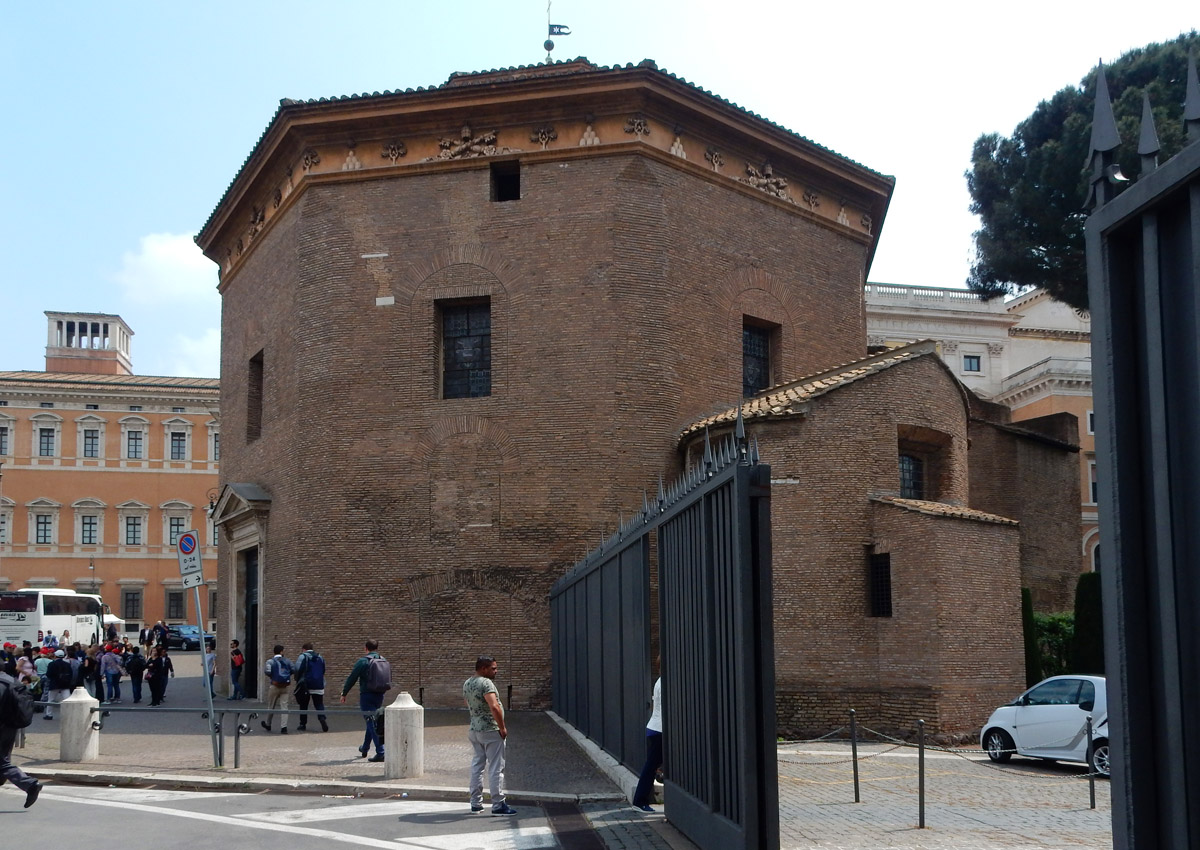 |
|||
| The plain exterior of this Baptistery in the Laterano shows that it has the same type of shape as the famous Baptistery in Florence, which is next to the Florence Duomo. | |||
 |
|||
| These old mosaics in the Baptistery look like they may be from the 4th Century BC, when the first church was constructed here. | |||
 |
|||
| The Baptistery. | |||
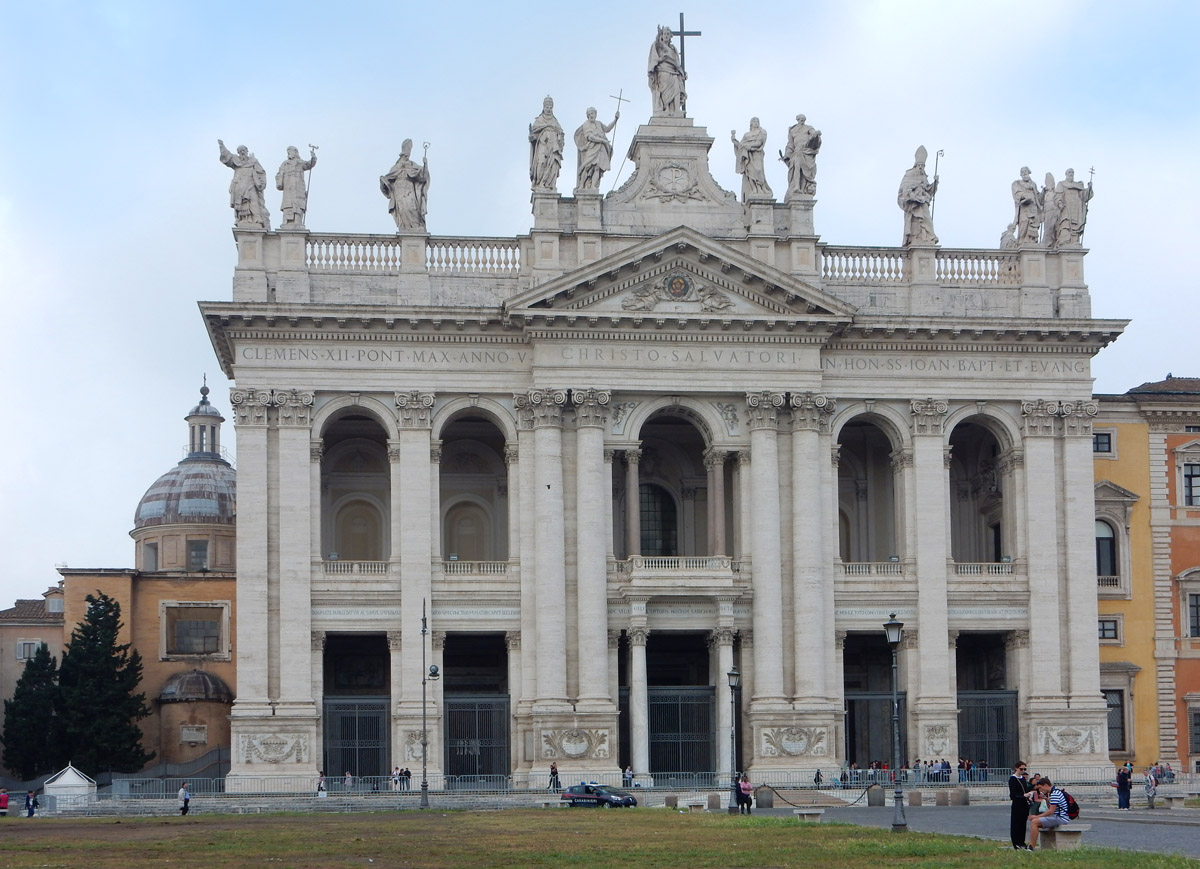 |
|||
| This is our final destination in Rome and it brings us full circle to the First Part of our Roman excursion. It is the Cathedral of Rome... or to give it its full title, "The Cathedral of the Most Holy Savior and of Saints John the Baptist and the Evangelist in the Lateran".
In Part One we explored the West Bank of the River Tiber, and there we found the Vatican City with Saint Peter's Basilica. It is easy to assume that Saint Peter's is the Cathedral of Rome, but it isn't. The building in the photo above holds that title. The Lateran Treaty of 1929 created the state of the Vatican City, and it also declared that the Cathedral of Rome, which is on the East Bank of the TIber, would be a small extension of Vatican City. So this Cathedral is the property of the Vatican, and a small part of the Vatican State. It is called an "Archbasilica" because it is the oldest and highest ranking of all the four papal major basilicas in Rome. |
|||
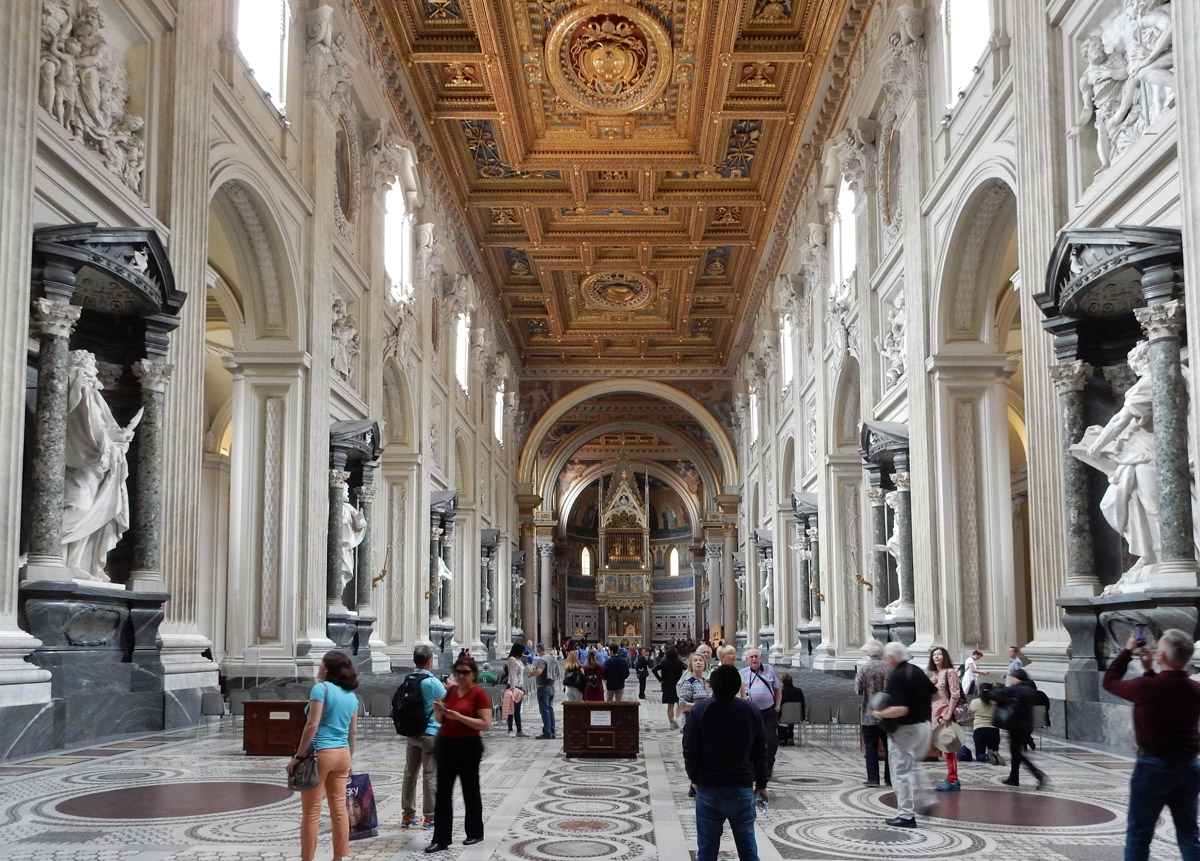 |
|||
| The Nave of the Cathedral of Rome, looking towards the Altar. | |||
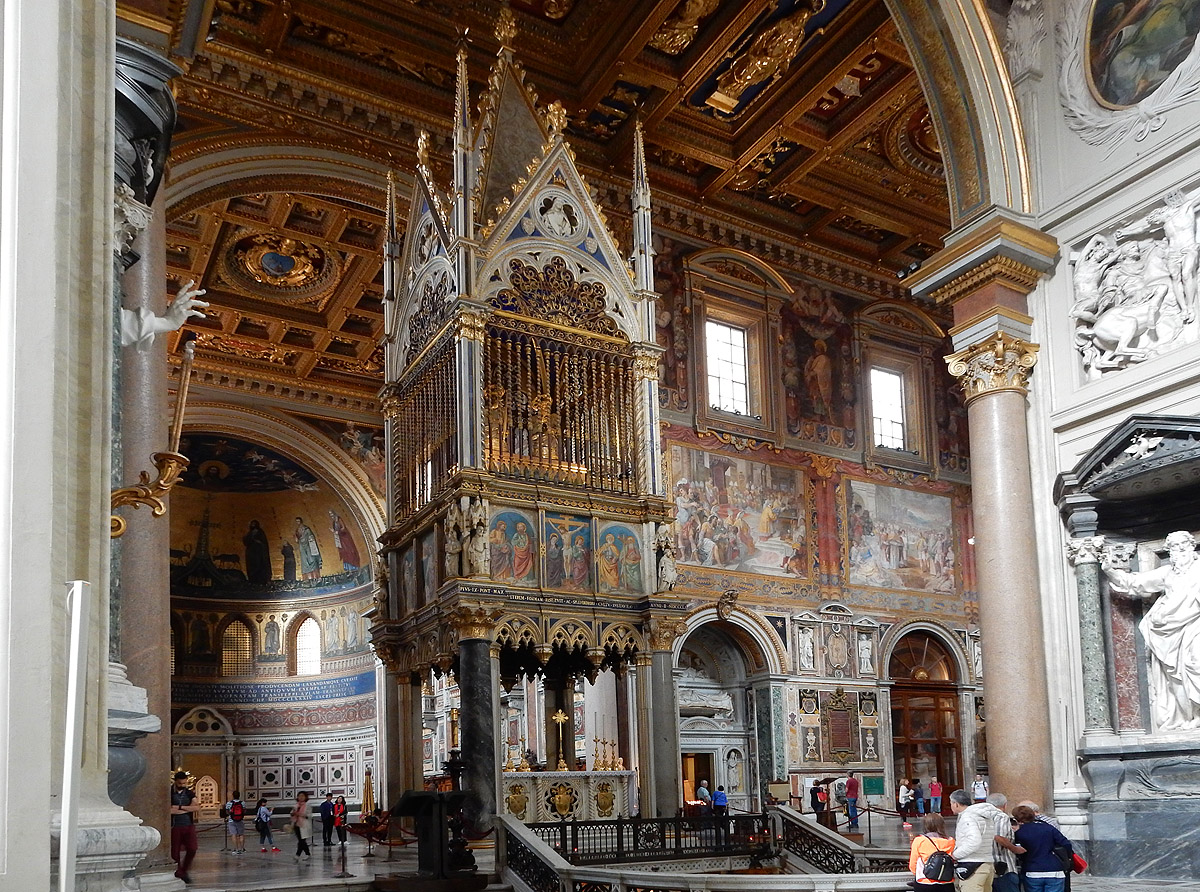 |
|||
| In the foreground we see the 14th Century Gothic ciborium (or baldachin). | |||
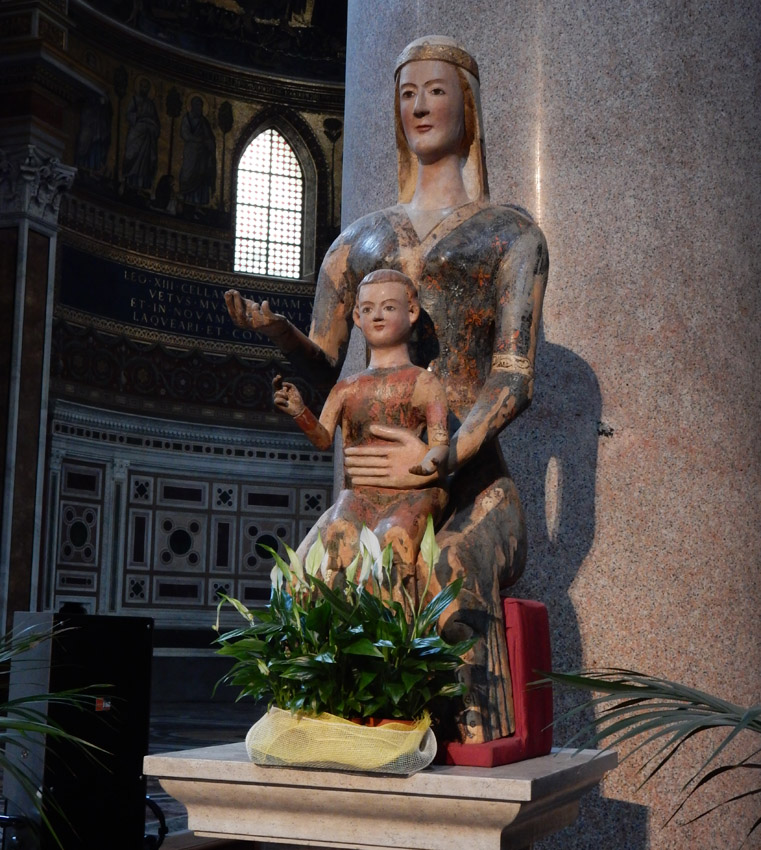 |
||||
| This is a 14th Century statue of the Madonna and Child, called the "Maria Madre della Chiesa". | ||||
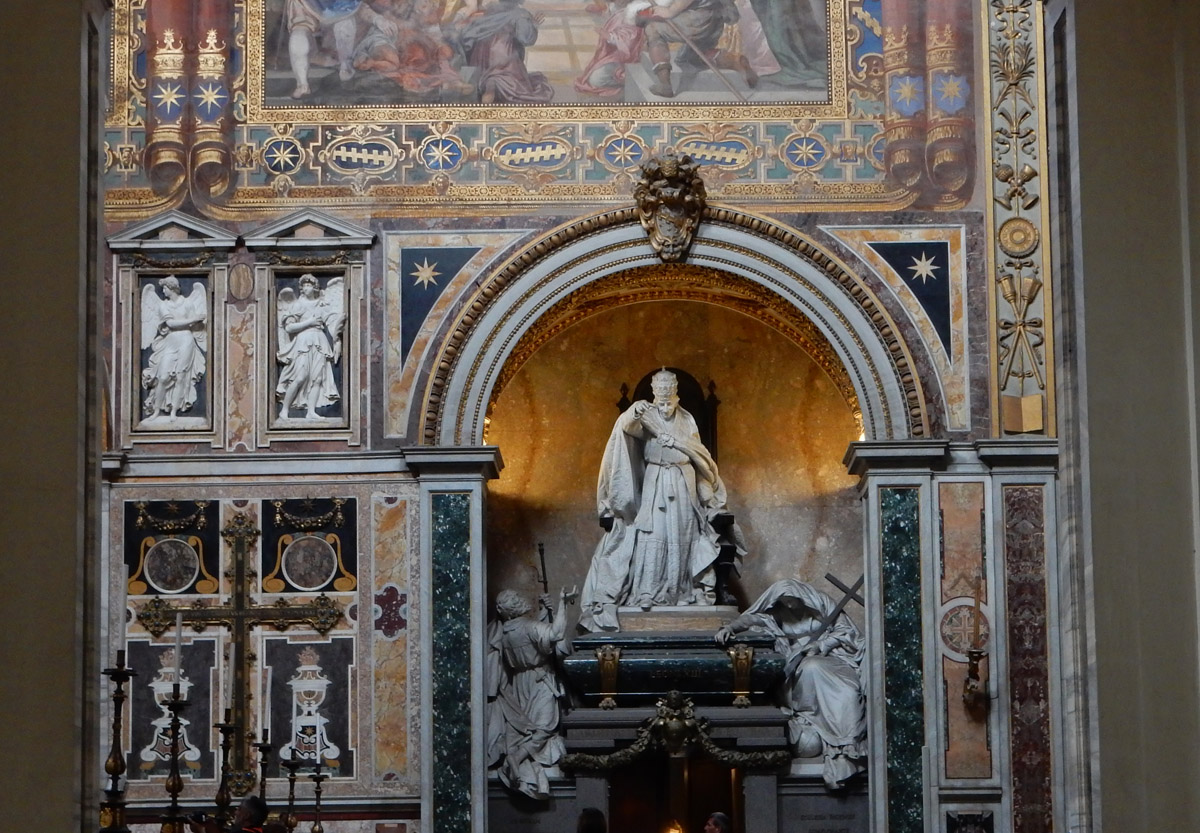 |
||
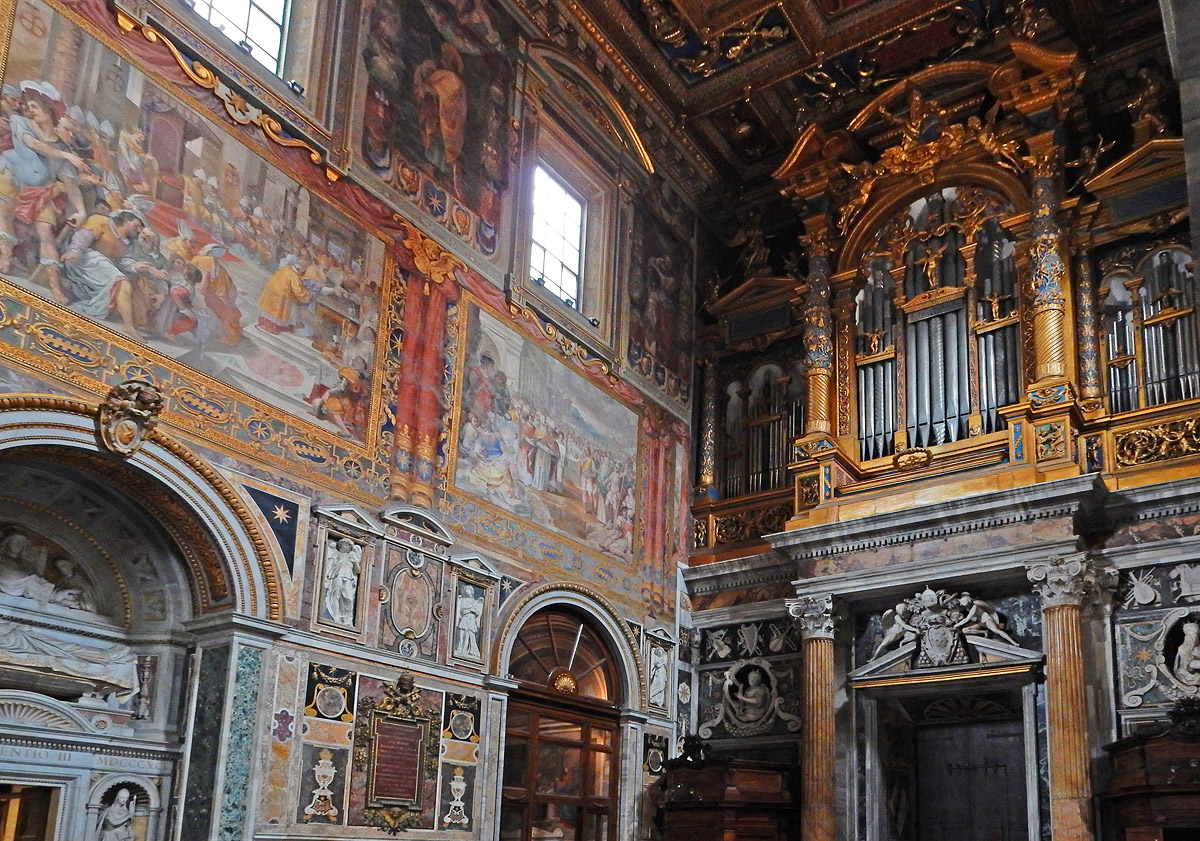 |
|||
| Thus ends our tour of Rome. | |||
|
To return to the Paintings section of this website, please CLICK HERE
|
|||